|
Meinem Lehrer und Freund Prof. Dr. Heinrich von Stietencron ist die gesamte Amarakośa-Übersetzung in Dankbarkeit gewidmet. |
Zitierweise | cite as: Amarasiṃha <6./8. Jhdt. n. Chr.>: Nāmaliṅgānuśāsana (Amarakośa) / übersetzt von Alois Payer <1944 - >. -- 2. Dvitīyaṃ kāṇḍam. -- 14. kṣatriyavargaḥ (Über Kṣatriyas). -- 2. Zweiter Abschnitt (Über Kriegsführung). -- 4. Vers 27 - 50b (Krieger I, Rüstung). -- Fassung vom 2011-09-14. -- URL: http://www.payer.de/amarakosa6/amara2142d.htm
Erstmals hier publiziert: 2011-09-14
Überarbeitungen:
©opyright: Creative Commons Lizenz (Namensnennung, keine kommerzielle Nutzung, share alike)
Dieser Text ist Teil der Abteilung Sanskrit von Tüpfli's Global Village Library
|
Meinem Lehrer und Freund Prof. Dr. Heinrich von Stietencron ist die gesamte Amarakośa-Übersetzung in Dankbarkeit gewidmet. |
Falls Sie die diakritischen Zeichen nicht dargestellt bekommen, installieren Sie eine Schrift mit Diakritika wie z.B. Tahoma.
Die Devanāgarī-Zeichen sind in Unicode kodiert. Sie benötigen also eine Unicode-Devanāgarī-Schrift.
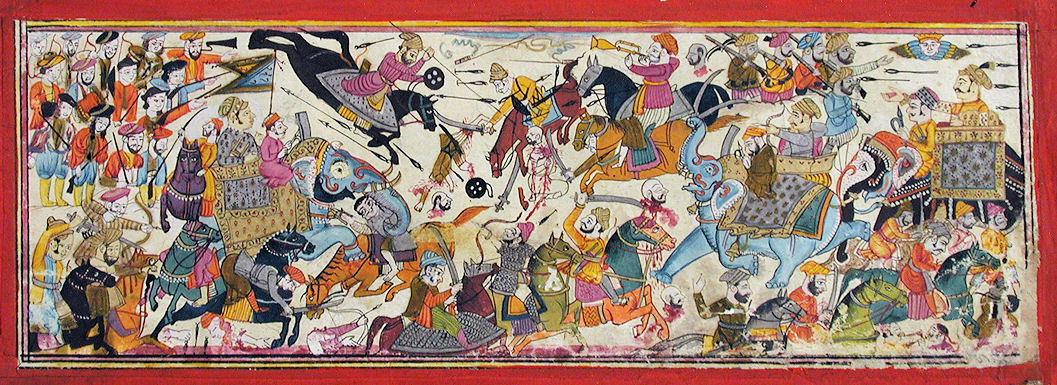
Abb.: Kampfszene, Bhāgavata-Purāṇa-Handschrift, Uttar Pradesh,
ca. 1780
[Bildquelle: Asian Curator at The San Diego Museum of Art. --
http://www.flickr.com/photos/asianartsandiego/4838434662/. -- Zugriff am
2011-04-10. --
Creative Commons Lizenz (Namensnennung, keine kommerzielle Nutzung,
keine Bearbeitung)]
|
27a. ādhoraṇā hastipakā
hastyārohā niṣādinaḥ आधोरणा हस्तिपका हस्त्यारोहा निषादिनः ।२७ क। [Bezeichnungen für Mahout:]
|
Colebrooke (1807): "Elephant drivers. Some restrict the two first terms to the keeper, and the two last to the warrior riding an elephant."
Siehe auch Vers 2 - 11b.
"Ein Mahut (auch: Mahout) ist der Führer und oftmals Eigentümer eines Arbeits-Elefanten. Er ist für dessen Ernährung und Pflege verantwortlich und über Jahrzehnte mit dem Tier verbunden. Ein Mahut reitet auf dem Nacken des Elefanten und dirigiert ihn mittels verbaler Kommandos, seines Elefantenstabs und des Drucks, den er mit Füßen und Beinen auf das Tier ausübt. Die Bezeichnung Mahut kommt von Hindi mahaut (महौत) bzw. mahāvat (महावत). Weitere Bezeichnungen sind etwa Sanskrit hastipaka (हस्तिपक), Birmanisch chaṅ-ūḥcīḥ oder „oozie“ (ဆင္ဦးစီး), Thai khwan chang (ควาญช้าง)."
[Quelle: http://de.wikipedia.org/wiki/Mahout. -- Zugriff am 2011-06-07.]
आधोरण - ādhoraṇa m.: Elefantentreiber, Mahout
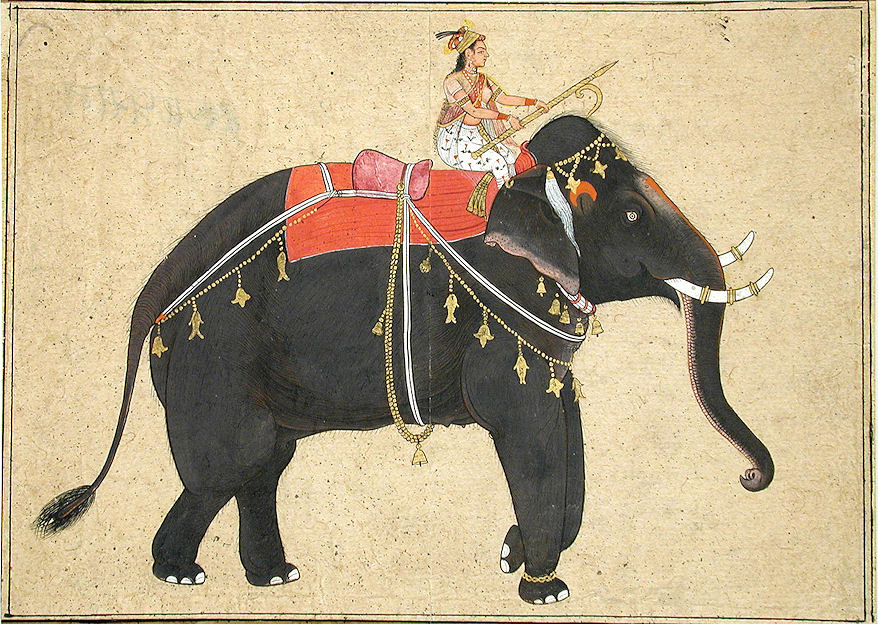
Abb.: आधोरणी । Elefant mit weiblichem Mahout (महौत), Andhra Pradesh, 18. Jhdt.
[Bildquelle: Asian Curator at The San Diego Museum of
Art. --
http://www.flickr.com/photos/asianartsandiego/4838273718/. -- Zugriff am
2011-04-13. --
Creative Commons Lizenz (Namensnennung, keine kommerzielle Nutzung,
keine Bearbeitung)]
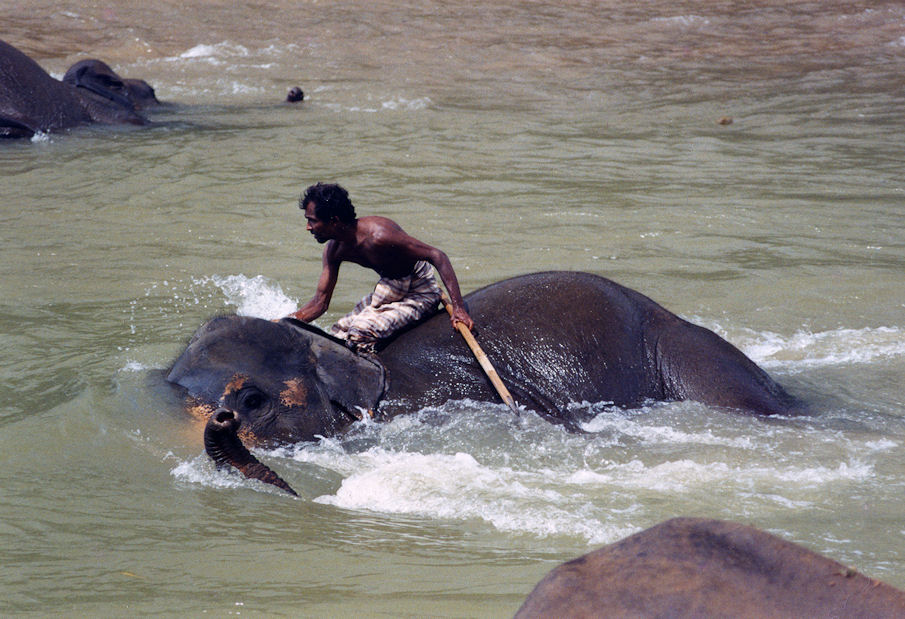
हस्तिपक - hastipaka m.: Elefantenwärter, Mahout
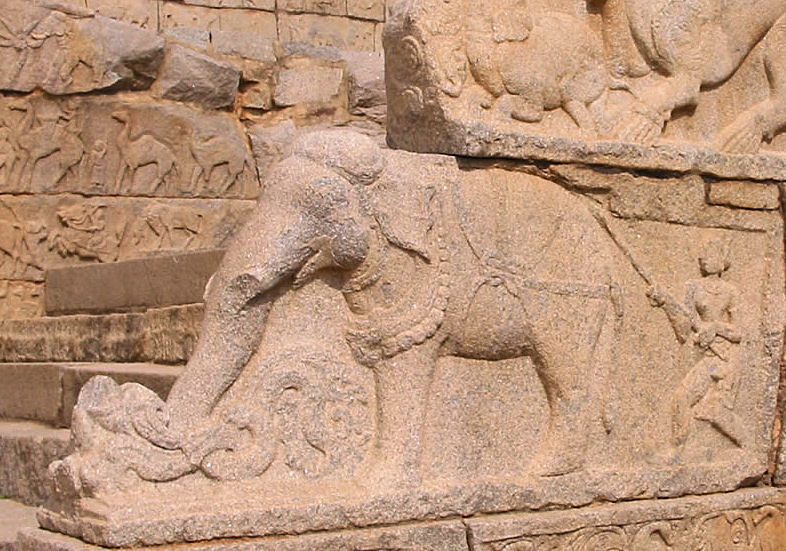
Abb.: हस्त्पकः ।
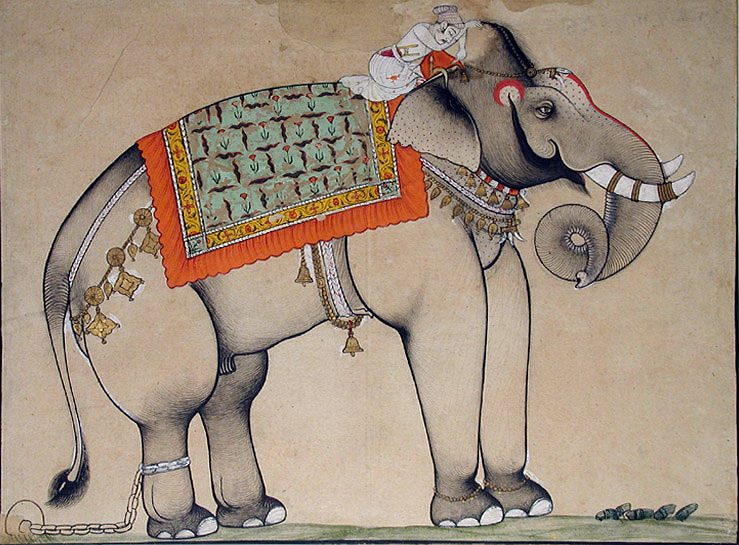
Abb.: हस्तिपकः । Schlafender Mahout, Rajasthan, ca. 1700
[Bildquelle: Asian Curator at The San Diego Museum of
Art. --
http://www.flickr.com/photos/asianartsandiego/4838372690/. -- Zugriff am
2011-06-07. --
Creative Commons Lizenz (Namensnennung, keine kommerzielle Nutzung,
keine Bearbeitung)]
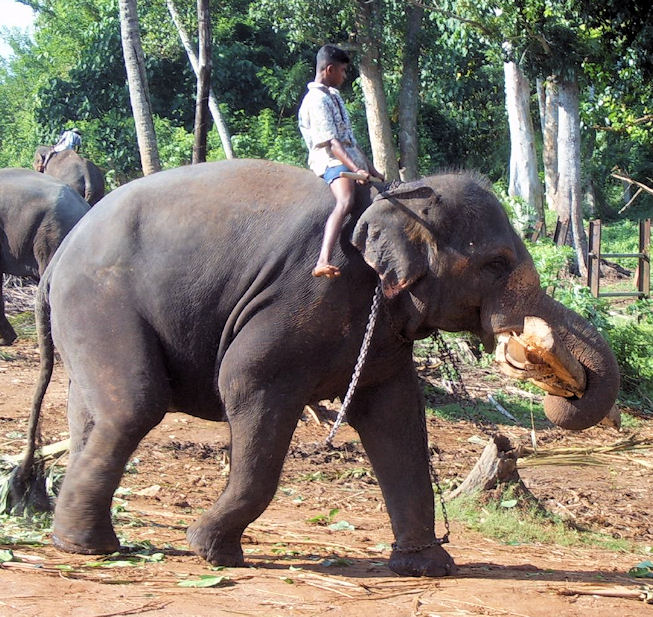
Abb.: हस्तिपकः । Pinnawela Elephant Orphanage - පින්නවල අලි අනාථාගාරය, Sri
Lanka
[Bildquelle: Petr Kosina. --
http://www.flickr.com/photos/clobrda/2835792981/. -- Zugriff am
2011-06-07. --
Creative Commons Lizenz (Namensnennung, keine kommerzielle Nutzung)]
|
27b.
ādhoraṇā hastipakā
hastyārohā niṣādinaḥ आधोरणा हस्तिपका हस्त्यारोहा निषादिनः ।२७ क। [Bezeichnungen für Elefantenreiter:]
|
Colebrooke (1807): "Elephant drivers. Some restrict the two first terms to the keeper, and the two last to the warrior riding an elephant."
हस्त्यारोह - hastyāroha m.: Elefantenreiter, Elefantenlenker
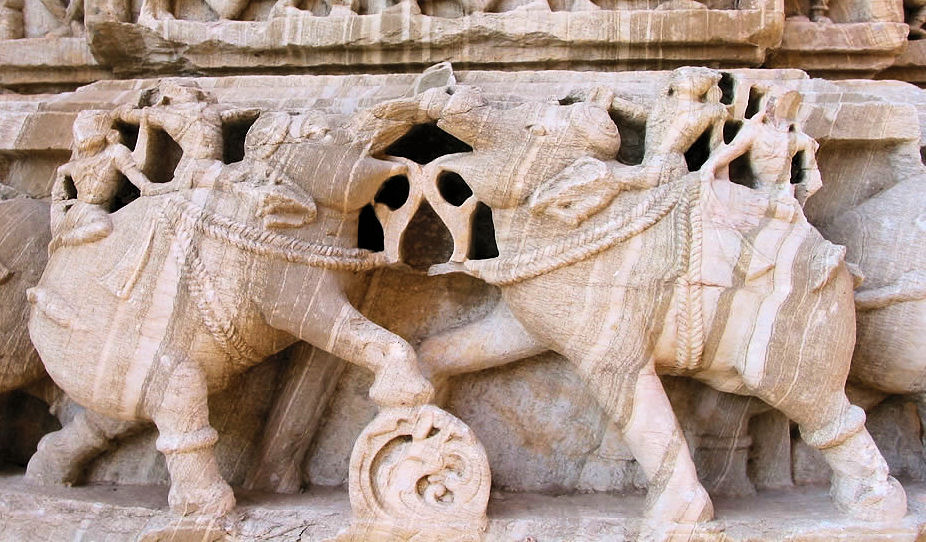
Abb.: हस्त्यारोहौ । Kriegselefanten, Chittor - चित्तौड, Rajasthan
[Bildquelle:
ૐ Dey Alexander ૐ.
--
http://www.flickr.com/photos/dey/3120936/. -- Zugriff am 2011-04-13. --
Creative
Commons Lizenz (Namensnennung, keine kommerzielle Nutzung, share alike)]
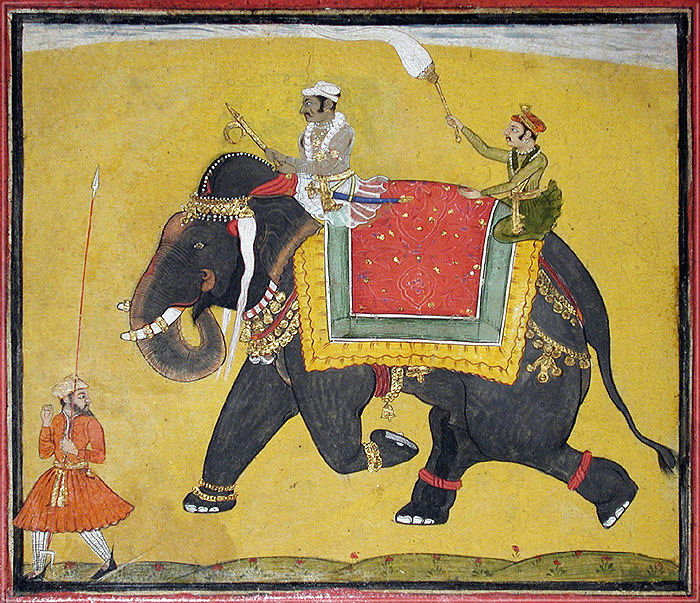
Abb.: हस्त्यारोहः । Rājā auf Elefant, Rajasthan, ca. 1690
[Bildquelle: Asian Curator at The San Diego Museum of
Art. --
http://www.flickr.com/photos/asianartsandiego/4838316164/. -- Zugriff am
2011-04-13. --
Creative Commons Lizenz (Namensnennung, keine kommerzielle Nutzung,
keine Bearbeitung)]
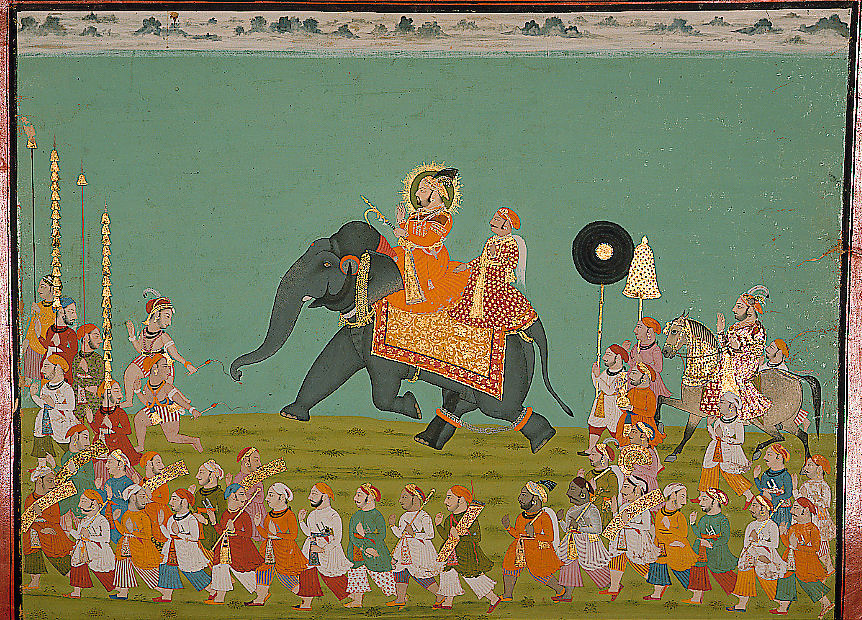
Abb.: हस्त्यारोहः । Jagat Singh II auf seinem Elefanten Bhamargaj, Rajasthan, ca. 1750
[Bildquelle: Asian Curator at The San Diego Museum of
Art. --
http://www.flickr.com/photos/asianartsandiego/4838300120/. -- Zugriff am
2011-04-13. --
Creative Commons Lizenz (Namensnennung, keine kommerzielle Nutzung,
keine Bearbeitung)]
निषादिन् - niṣādin m.: Aufsitzer
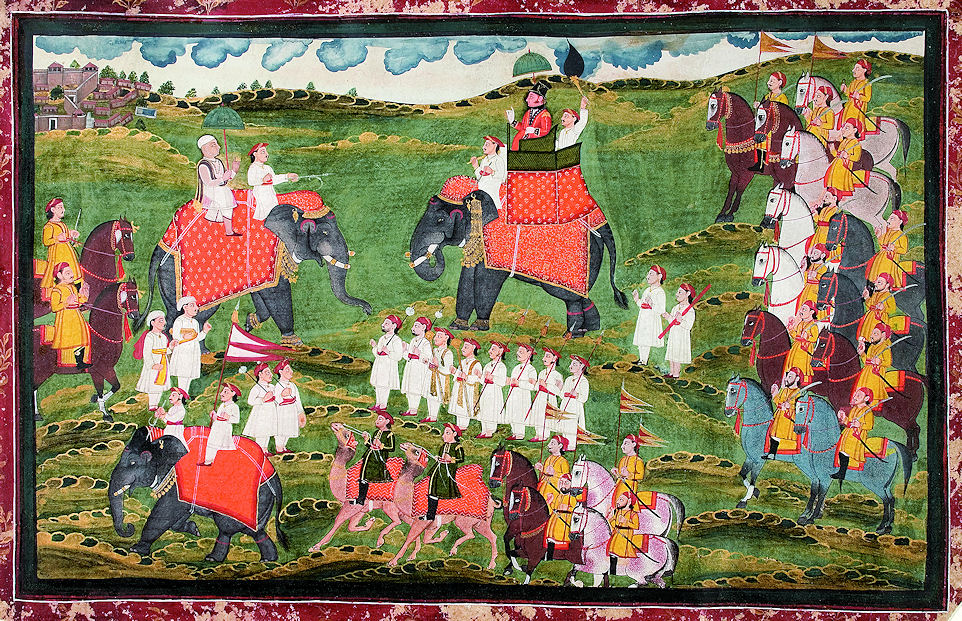
Abb.: निषादी । Captain James Tod (1782 - 1835) auf Elefant, Rajsthan, 1822
[Bildquelle: Asian Curator at The San Diego Museum of
Art. --
http://www.flickr.com/photos/asianartsandiego/4837702045/s. -- Zugriff am
2011-04-13. --
Creative Commons Lizenz (Namensnennung, keine kommerzielle Nutzung,
keine Bearbeitung)]
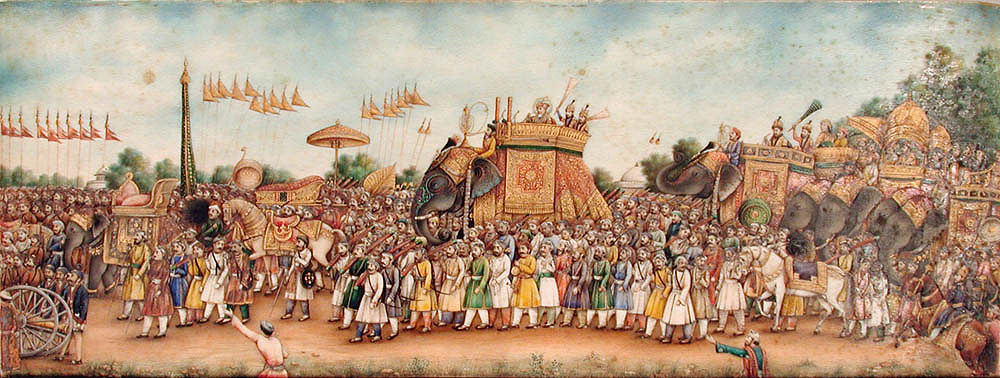
Abb.:
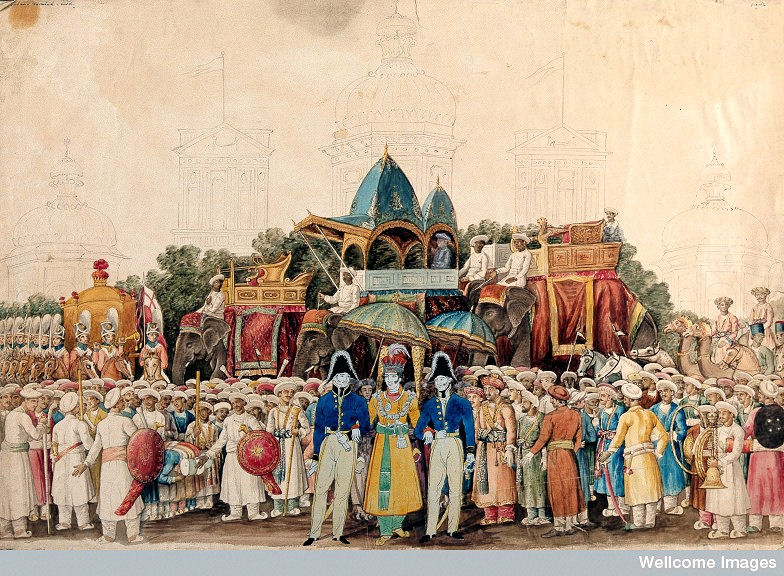
Abb.:
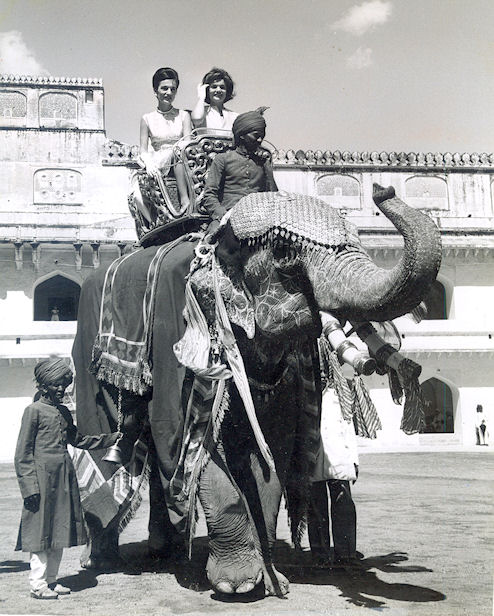
Abb.:
"The elephant-riders. The common names for the elephant used in the Epic, gaja, nāga, dvipa, hastin, kareṇu, karin, dantin, dvirada, mātaṅga, kuñjara, vāraṇa, pota, for the most part serve merely as plain descriptive adjectives ('the twice-drinker,' 'the handed one,' 'the tusked one,' ' the defender,' etc.), and are synonymous.
These beasts were employed en masse as a moving wall in attack at the outset of battle, as a standing wall in defense, and, thirdly, as individual foragers through the confused crowd of blood-seeking desperadoes that make the back-ground of every battle-scene. More rarely, they were used by respectable knights in a civilized manner. But, as generally presented to us, we find them mounted by a gang of low soldiers sitting on the shoulders of the beast (gajaskandhāḥ), who were armed with knives, daggers, pots of oil, stones, and other weapons and missiles, with winch to strike the soldiers beneath. The gajārohāḥ or hastisādinaḥ were also set to catch the victims below by the hair and then cleave their necks, or to slip forward upon the tusks and slay the horses or men that the weapons of the beasts might miss. The cavalry are especially forward in attacking elephants, but always covertly. It required a special study to be master of an elephant, and the 'elephant-science' was an important part of military discipline. The weapons usually employed against the elephant are (iron) arrows; but the statement sometimes made in the Epic, that a knight kills an elephant with one arrow, like so many others of like nature, must be taken with the latitude that Hindu longitude demands. The remark of Arjuna that he can kill the Kirāṭa with the end of his bow, as a man does an elephant with the end of a sharp stake (of iron), shows perhaps that this was the method of disposing of them if they became ungovernable. The great chiefs, princes, kings, mount elephants so rarely that we may be entitled to infer that the practice of a king's fighting from a great howdah (vimāna) on an elephant's back is later than the other method of air-lighting, and that mention of it will be among the later additions. It was probably first customary in peaceful jaunts, and then extended to war; the latter must have been synchronous with abdication of warrior prowess in the main ; yet we find a few instances of elephants being ridden in war, notably by the Yavana prince.
The elephants were attended by 'protectors,' both the animal that served as general 'guard of the herd, and the human flank-protectors, of which we find four, one for each corner of the beast. But we also find seven car-men, guard of one elephant, as the normal number.
The still more formal distribution of forces gives a rather different picture of the relative use of the elephant. This account groups all the fighters engaged, and may be here given in full. The elephants are looked upon in this passage not as an independent array, but as adjuncts to the knights in chariots, ten or fifty about each car. Here we find that seven men (not in chariots, as above) attend each elephant, two leading it by hooks (aṅkuśadharau), two carrying bows, two carrying swords, one carrying a spear and club (śaktipinākadhṛt). According to the same description, the distribution of horse-riders was thus: if each war-car had ten elephants, then each elephant had ten horse-riders, and each horse-rider in turn had a guard of ten foot-men, pādarakṣāḥ ; if each car had fifty elephants, then each elephant had one hundred horsemen, and each horseman seven foot-men.
These 'mountainous beasts' (viii. 85.4, etc.) are armed with spikes and iron harness. They wear a kakṣyā or girth about the middle, and carry flags, vaijayantī, emblems, hooks, quivers, guards, neckchains, bells, wreaths, nets, umbrellas, and blankets, possibly with rings about the feet.
The tottra, prod, and aṅkuśa, hook, are used to urge and direct the beast. To these we nave perhaps kaṅkaṭa to add, as a goad. The elephant is at his best when sixty years old, and then a type of male vigor; gift-elephants are so spoken of, this being the perfect age. But even a young elephant is formidable: 'then he became a young elephant' is a self-explaining metaphor on the battle-field. No special sagacity is shown by the elephants, except in the burning of a forest, where they try to squirt the fire out (i. 223.80); but they are celebrated, as the horses are, for their endurance of noises when well-trained (ii. 61.16); and, like the horses, they weep in battle. They are occasionally called by pet names. Droṇa names his elephant for his son. A sort praised in vii. 112.17 is añjanaka. The metaphor of the horse impatient under the whip is repeated in the case of the word-wounded knight enduring contempt as little as an elephant crazed by the hook. Their terrible noise is often alluded to."
[Quelle: Hopkins, Edward W. (Washburn) <1857 - 1932>: The social and military position of the ruling caste in ancient India; as represented by the Sanskrit epic; with an appendix on the status of woman. -- Reprint from the 13th volume of the Journal of the American Oriental Society (1888). -- New Haven, Conn. : Tuttle, 1889. -- S. 265-269]
| 27c./d. niyantā prājitā yantā sūtaḥ
kṣattā ca sārathiḥ 28a./b. savyeṣṭha-dakṣiṇasthau ca saṃjñā rathakuṭumbinaḥ नियन्ता
प्राजिता यन्ता सूतः क्षत्ता च सारथिः ॥२७ ख॥ Bezeichnungen für Wagenlenker (रथकुटुम्बिन् - rathakuṭumbin m.: "Hausvater des Wagens"):
|
Colebrooke (1807): "A charioteer. Some erroneously make the two last terms signify the carriage horses yoked right and left."
Siehe auch Vers 19-26.
रथकुटुम्बिन् - rathakuṭumbin m.: "Hausvater des Wagens", Wagenlenker
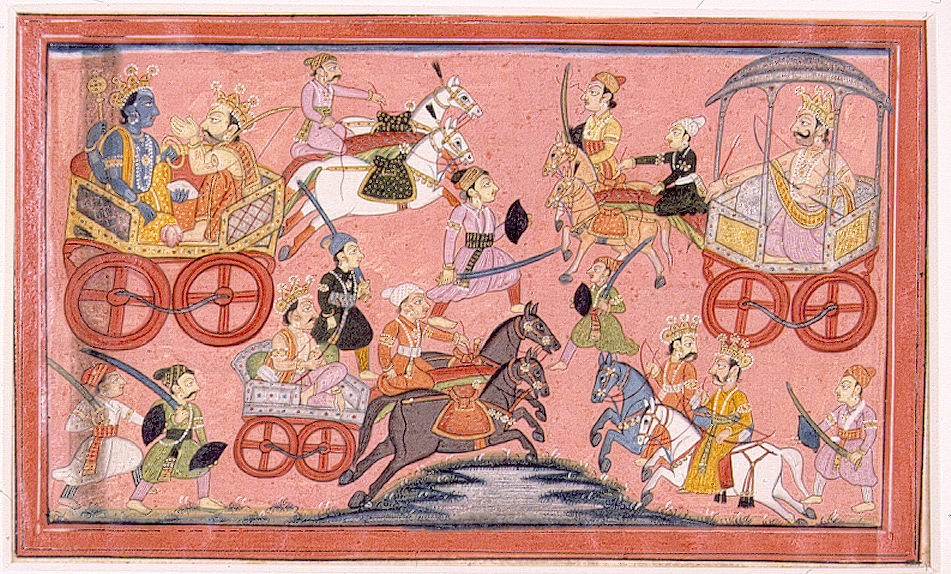
Abb.: रथकुटुम्बिनः । Arjuna verehrt Kṛṣṇa, Bilaspur - बिलासपुर, Himachal
Pradesh, 1750?
[Bildquelle: Asian Curator at The San Diego Museum of
Art. --
http://www.flickr.com/photos/asianartsandiego/4838480158/. -- Zugriff am
2011-06-08. --
Creative Commons Lizenz (Namensnennung, keine kommerzielle Nutzung,
keine Bearbeitung)]
नियन्तृ - niyantṛ m.: Zügler, Bändiger, Wagenlenker
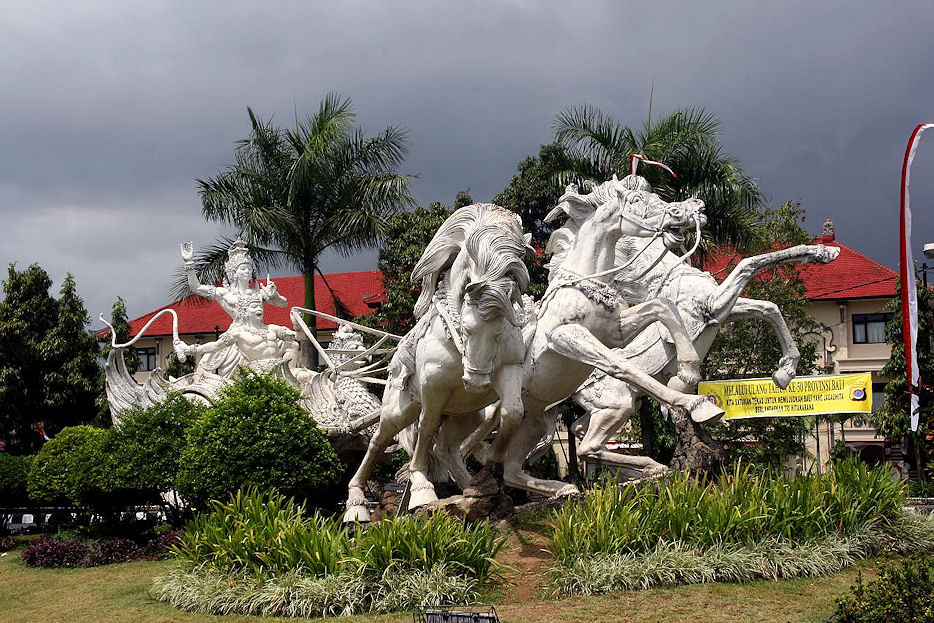
Abb.: नियन्ता । Kṛṣṇa als Wagenlenker Arjunas, Denpasar, Bali, Indonesien
[Bildquelle: Deepak Bhatia. --
http://www.flickr.com/photos/zeepack/2798815917/. -- Zugriff am
2011-06-08. --
Creative Commons Lizenz (Namensnennung, keine Bearbeitung)]
प्राजितृ - prājitṛ m.: Antreiber
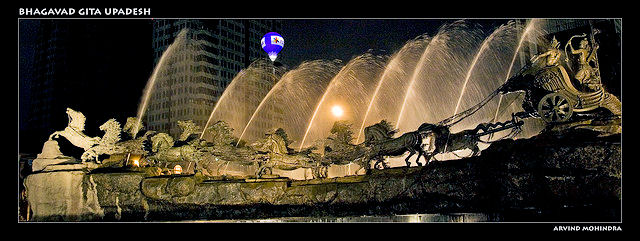
Abb.: प्राजिता । Kṛṣṇa als Arjunas Wagenlenker, Bhagavad Gita Upadesh,
Jakarta, Indonesien
[Bildquelle: Doors of Perception!. --
http://www.flickr.com/photos/7971389@N03/525625874/. -- Zugriff am
2011-06-08. --
Creative Commons Lizenz (Namensnennung, keine kommerzielle Nutzung,
keine Bearbeitung)]
यन्तृ - yantṛ m.: Zügler, Bändiger, Lenker
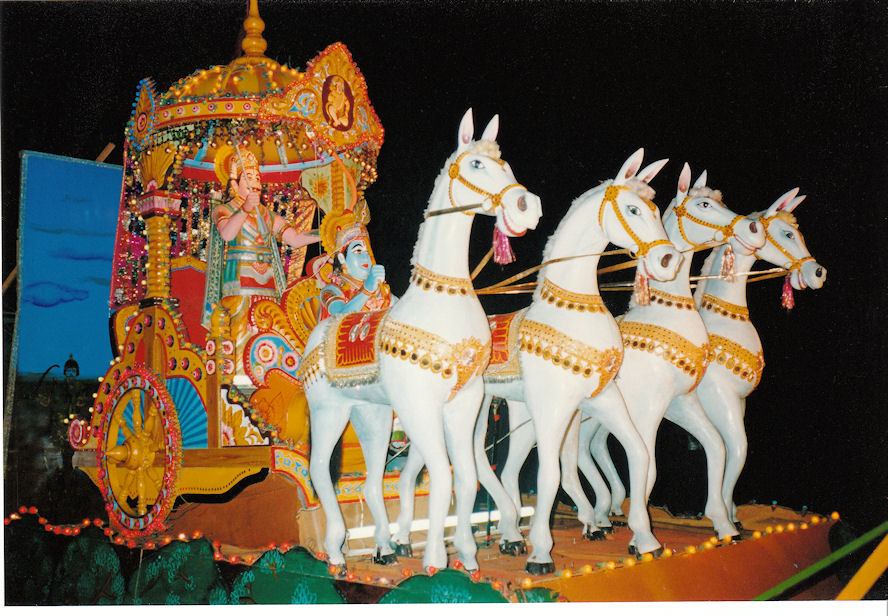
Abb.: यन्ता । Kṛṣṇa als Wagenlenker Arjunas, Varkala - വര്ക്കല, Kerala
[Bildquelle: Philippe Raffard / Wikimedia. -- GNU FDLicense]
सूत - sūta m.: Herold, Wagenlenker
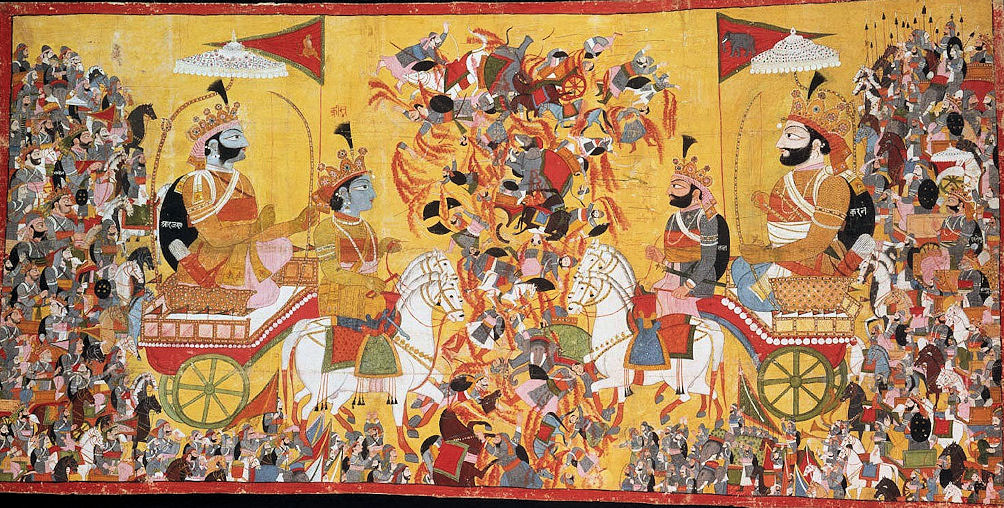
Abb.: सूतः । Wagenlenker Kṛṣṇa, Arjuna gegen Karṇa, ca. 1830
[Bildquelle: Wikipedia. -- Public domain]
क्षत्तृ - kṣattṛ m.: Aufwärter, Wagenlenker
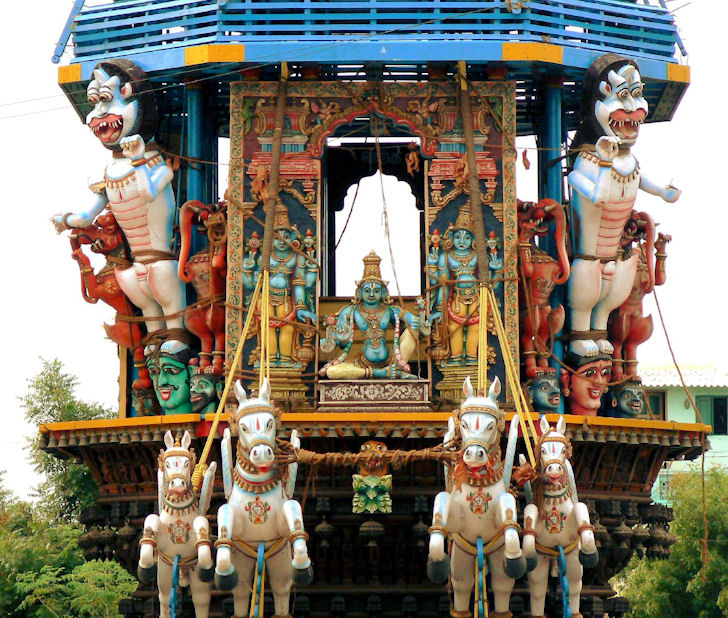
Abb.: क्षत्ता । Kṛṣṇa als Wagenlenker, Tempelwagen, Sriperumbudur -
திருபெரும்புதூர்,
Tamil Nadu
[Bildquelle: balaji shankar venkatachari.
--
http://www.flickr.com/photos/balaji_shankar/212311977/. -- Zugriff am
2011-06-08. --
Creative Commons Lizenz (Namensnennung, keine kommerzielle Nutzung)]
सारथि् - sārathi m.: Kriegswagenlenker
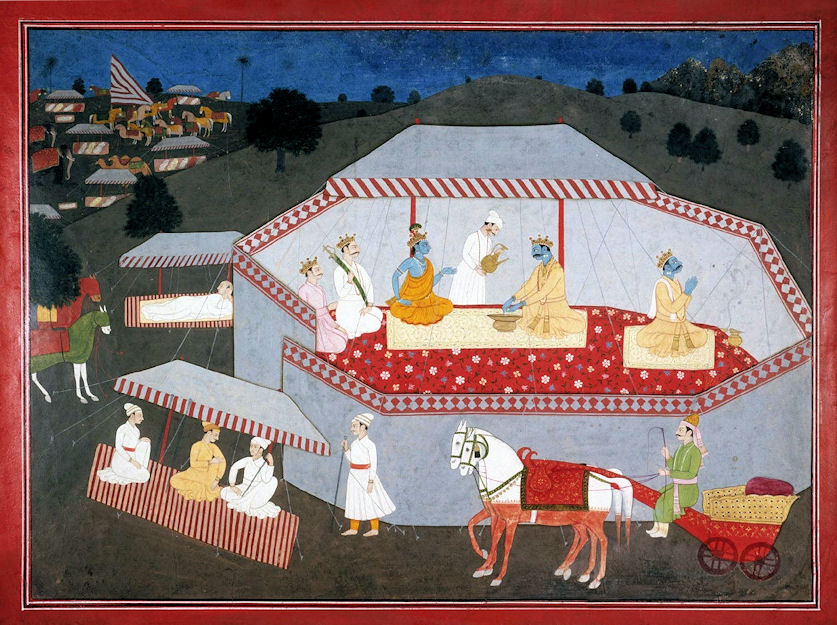
Abb.: सारथिः । "The Pandava prince Arjuna chooses to have
the unarmed Krishna as his charioteer rather than the reinforcement of
Krishna's large army. The Krishna's large army is chosen by the Kaurava
prince Duryodhana. As the sky turns from gray to azure, and the army begins
to wake, Arjuna confirms his decision by a solemn vow and water is poured
over his hands as ritual witness.", Himachal Pradesh, 1790/1800
[Bildquelle: Wikimedia. -- Public domain]
सव्येष्ठ - savyeṣṭha m.: links (vom Wagenkämpfer) stehend, Wagenlenker
दक्षिणस्थ - dakṣiṇastha m.: rechts (vom Wagenkämpfer) stehend, Wagenlenker
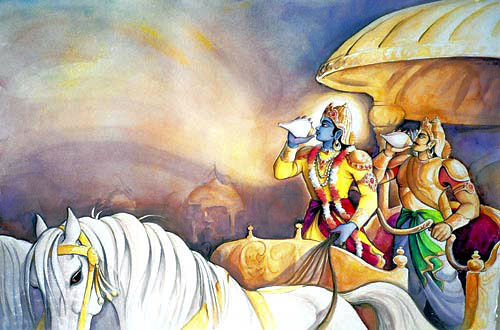
Abb.: दक्षिणस्थः । Kṛṣṇa und Arjuna
[Bildquelle: ISKCON desire tree. --
http://www.flickr.com/photos/iskcondesiretree/3797420873/. -- Zugriff am
2011-06-08. --
Creative Commons Lizenz (Namensnennung, keine kommerzielle Nutzung,
keine Bearbeitung)]
"The charioteer, sūta, sārathi, yantar, niyantar, rathayantārau, pārṣniyantar, pārṣṇisārathi, abhīśugraha (viii. 32.19), rathavāhaka, rathin (abstract, sārathyam): The car held one or three charioteers. Two alone seem sometimes implied (e. g. vii. 156.83 ff.). Often, however, the knight is his own driver. One kingly knight sometimes drives for another, as Kṛṣṇa for Arjuna and Śalya for Karṇa. But the social position of the charioteer is, as seen from Śalya's indignation in the scene quoted at length above (p. 217), one inferior to the knight's in the war-car. He only served for political purposes. There remained enough of the cattle-driver extraction in Karṇa to warrant this, but the dialogue shows the position of the ordinary charioteer to be properly that of a high servant. Of kings the charioteers were not thought unequal to high station, and princes in distress adopt this mode of life by preference. Thus Nala becomes chief hostler, and passes his time in the stable, aśvaśālā ; and Nakula takes service as a horse-trainer. Sañjaya, however, the old charioteer, shares his old king's hermitage. Of less than kings, the drivers were apparently of little importance; they generally fall in battle unnamed. Still, the practical position outweighs the theoretical station. We find the charioteer refusing to obey when the knight gives too reckless commands, but yielding when pressed. He is a servant, but a privileged one. Moreover, it was the charioteer's duty to guard his knight; and this may easily have been interpreted to imply keeping him out of death's way. Compare the vivid scene in the seventh book: 'Then he urged on the (one) charioteer: "drive thou the steeds quickly before the face of Droṇa"; . . . and again he urged on the driver, saying "go, go" (yāhi, yāhi); but the driver said, "thou art not skilled enough in fighting." Then cried the knight, "I would indeed fight now, even with the gods! Drive on!" and the charioteer, striking with his goad the three- year-old colts, drove on; but he did not rejoice in his mind.'
The rule of protecting the knight is formal. 'In battle the knight, if confused, must be guarded by the charioteer'; or, 'ever must the man of the war-car be guarded'; and when the charioteer risks his life in saving his master, he does so because he 'bears in mind the rule.' It will have been noticed that we have in the case above but one driver. Side by side with this we find two more, the sūta or charioteer proper being understood, especially noted as the pārṣṇisārathī, or twain standing on either side of the car, perhaps over the fore-wheels (see above), who guides the horses running free outside the pole- horses (vii. 48.29). Perhaps we have, conversely, to understand the two in a large car when but one is mentioned, as in the following; but I see no reason for this except the difficulty of one driver's managing a four-in-hand, which is slight, since there is nothing to disprove the possibility of all four horses being on the pole—though this is against usage. Compare: 'Light-handed he shot (a flood of arrows) at the foe's head, neck, hand, foot, bow, horses (pl.), umbrella, standard, charioteer (niyantar), three-fold-piece, seat (talpa), wheels, yoke, quiver, back-board, flag, two wheel-guards, and all the belongings of his car; down fell the knight wounded in all his adornments and garments, down upon the earth, like a tree bruised by a great wind.' The completeness of description might here be taken as excluding the outer drivers.
We find the king of the Pāṇḍus acting the part of a driver beside the regular charioteer. The art of the driver consisted not alone in driving well and fast, and keeping the car straight, for this indeed was but the foundation of his science. His true art consisted in wheeling and turning, in bringing the car rapidly about, so as to attack the antagonist with such speed from all quarters that the chariot seemed to advance from all sides at once. Reference has been made to this art in the paragraph on the battle-orders. The circumstances in which the knight or his driver exercises his skill are always the same, either to escape surrounding on the part of the foe or to surround. The names of the circles are apparently technical, in as great a degree as technicalities can be predicated of the transparent battle-terms employed. We have seen the 'right' and 'left' circles spoken of: that is, the 'circle,' maṇḍala, is the regular term for the evolution, to which we have added either yamaka, 'the double wheel,' or 'left' and 'right,' distributively. Either of the latter is, again, called a 'crescent,' ardhacandra. The Rāmāyana, in a doubtful passage, uses the words vīthī and sarpagatī in as if a technical sense, like maṇḍala, corresponding to (yuddha-)mārga, and it may be that in the Mahābhārata also these words have escaped my notice so used; but I can cite no instance of them from the latter work. The effect of 'circling' was produced by 'goading the steeds and hauling on the reins:' directing them, of course, by the latter at the same time.
A further trick of the charioteer is that of driving in such a way as to make a particular kind of noise. Perhaps no more than what corresponds to our individual trick of tread is meant, but we find that an unseen charioteer is recognized simply by the noise he makes in driving. This may be merely the grandeur and loudness of the sound, and it is withal in a 'tale of old' that the fact is mentioned ; but as a man used to the track can recognize one locomotive out of a hundred by ear alone, though bell and whistle be not used, I see no reason why in a chariot-age the same fineness of ear should not be possible, even if in one case the individuality lies in the engine and in the other in the engineer's method. Loudness of noise alone is often approvingly alluded to (e. g. R. vi. 79.11).
I have already spoken of the eagerness with which a decent knight slays his foe's charioteer. The ensign and charioteer are often aimed at first, and these with the horses being laid low, the knight-to-knight combat first begins. Every scene will give examples of this statement, and a few references will suffice. It was a very mean and cowardly practice, and engaged in without compunction. The driver was absolutely helpless. The opposing knight looked on him as he did on the horses, and shot him to stop the car. No qualms of honor seem to have been felt; yet the driver was the most unprotected man in the field. The 'code' had not touched him. Even as against the opposing knight, thus destitute of horses and driver, the combat was unfair; but this is the regular usage.
An important casual occupation of the trusted charioteer lies in the office of herald or ambassador, nominally under safety, but endangered by a wrathful prince. Deprecating possible wrath, he was supposed to repeat verbal messages, while acting rather as an agent sent to confer. As daily herald to town from camp goes the charioteer of old Dhṛtarāṣṭra, and appears as an old friend of the king. So in the Rāmāyana a charioteer, sārathi, is sent with a message to the king (ii. 57.23). Regular news-seekers were the spies, always taken for granted in each camp. The news of Arjuna's vow is carried across by spies to the other camp (vii. 74.1). The news of defeat is brought the king by messengers called vārttikāḥ; not by the sūta that had been the daily reporter of events.
We have also to notice that the sūta or professional driver was retained in peace as a musician, and seems in this capacity to have been employed as a regular eulogizer in feasts and processions, along with bandins and māqadhas. Of the number of charioteers employed by a wealthy potentate we can form no estimate. The Epic says that Yudhiṣṭhira, when king of Indraprastha, possessed eight hundred sūtas with māgadhas, perhaps only musicians.
The sūta had not only to drive but to attend to the horses, put them up, take care of them, and, after battle, draw the arrows out of them and doctor them (v. 180.1)."
[Quelle: Hopkins, Edward W. (Washburn) <1857 - 1932>: The social and military position of the ruling caste in ancient India; as represented by the Sanskrit epic; with an appendix on the status of woman. -- Reprint from the 13th volume of the Journal of the American Oriental Society (1888). -- New Haven, Conn. : Tuttle, 1889. -- S. 251 - 255]
|
28c./d. rathinaḥ syandanārohā aśvārohās tu sādinaḥ रथिनः स्यन्दनारोहा अश्वरोहास् तु सादिनः ॥२८ ख॥ [Bezeichnungen für Wagenkämpfer:]
|
Colebrooke (1807): "Warriors in chariots."
रथिन् - rathin m.: Wagenkämpfer
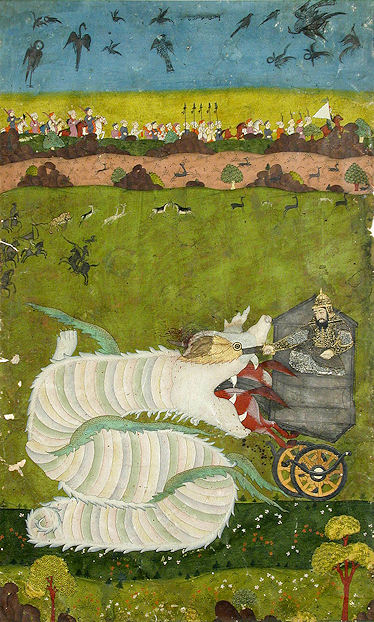
Abb.: रथी । Esfandiar (اسفنديار)
bekämpft den Drachen, Deccan, ca. 1760
[Bildquelle: Asian Curator at The San Diego Museum of
Art. --
http://www.flickr.com/photos/asianartsandiego/4837660705/. -- Zugriff am
2011-06-08. --
Creative Commons Lizenz (Namensnennung, keine kommerzielle Nutzung,
keine Bearbeitung)]
स्यन्दनारोह - syandanāroha m.: "Wagen-Besteiger", Wagenkämpfer
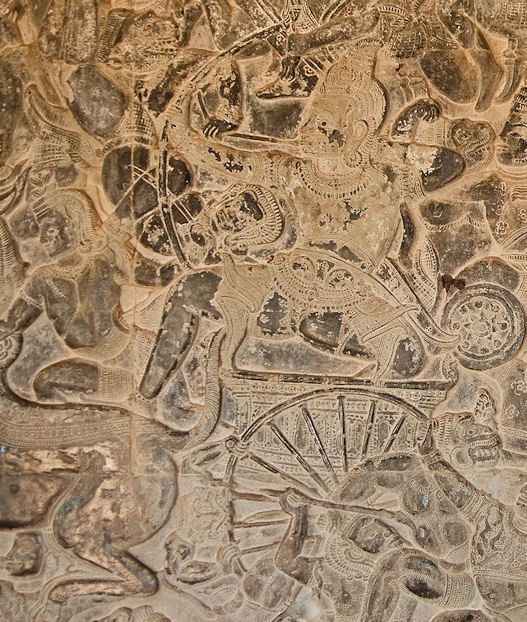
Abb.:
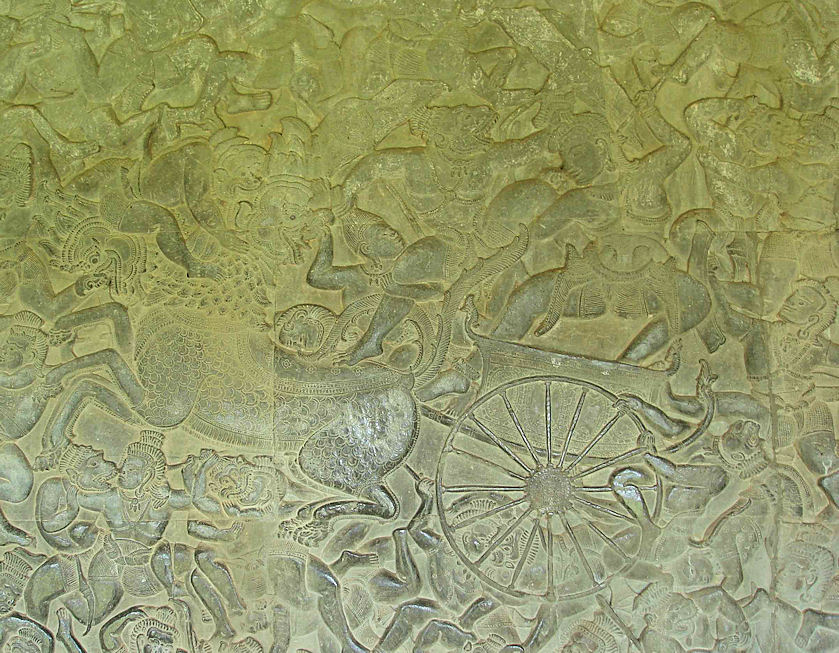
Abb.: स्यन्दनारोहः । Schlacht auf Kurukṣetra, Angkor Wat
"The knight of the war-car: A few words in regard to the personal position of the knight of the chariot, before we turn to the cavalry and elephants, or examine the arms of all these fighters. The well-born knight, śūra, sometimes vīra (though this may not imply nobility), is separated by various grades from those around him, and his performances as a fighter are, so to speak, adjusted to these grades. In nearest proximity is the charioteer, his friend it may be, but socially beneath him. Around him are certain followers and retainers. Of these, supposing him to be a prince or high noble, we must make three divisions. First and nearest stand his 'wheel-guard,' usually one knight each at the sides of his car. These are no humble followers, but his equals in rank, although, as examples show, often his inferiors in age. It is an honorable office for young knights so to 'guard the wheels' of a great champion, and in all probability, remembering the adolescence of many of these young warriors, it was a post sought for them by their parents, that they might not only be taught how to fight, but be protected in the battles by the presence of the champion. Thus Abhimanyu seems to be put under the care of Yudhiṣṭhira. The knight is the head of his clan. He is the captain of a large family body. But in the vast hosts depicted in the Epic, we find knights or kings standing at the head of whole hosts, comprising not only the family or clan but hired troops. These bhṛta or mercenaries form the third group behind the knight. They are of no importance except as a mass. The knights pay little attention to them, and stand to them in a merely formal relation. But between these two—the family friends or near relations guarding the wheel, and the foot-herd behind, padānnugāḥ—stand the nearer 'followers' of the knight. These are comprised under the name of anugāḥ or anucarāḥ, and differ from the closer friends as from the vulgar. Among the sainikāḥ or general soldiers, the anugāḥ were the knight's particular backers. I think we shall not err if we take the anugāḥ or anucarāh to mean those immediate followers representing what remains of the clannish corps of an older age. The anucara is perhaps nearer than the padānuga, and therefore differentiated from him; but he seems to be the same as anuga. There seems to be a certain personal familiarity between these 'followers' and their knight, explainable only on such an assumption. At the knights death they invariably flee; they are bound up in his success or failure. The anuga is often beloved, and we find Karṇa weeping when he sees his anuga Durmukha slain, just sent forward to his assistance (vii. 134). As his name denotes, the anuga is strictly a 'follower,' to whom conversely the knight is a puraḥsara, 'leader.' To illustrate the connection between knight and followers it may be noted that, in the River-Vision (the most poetical chapter of the whole Epic), each knight returns to earth for a time, appearing to the eyes of his friends, 'bearing the same standard, and with the same car and dress,' as of old; but after the vision has lasted for a little it fades away, and each ghostly warrior returns to his own place in the world of the dead 'with his steeds and with his padānugāḥ,' so that these accompany him after death, an before. Here the whole general multitude that had died in meant.
One knight often drives just behind another to protect him, the Hindu notion of defense being not to impede the darts of the protected, still less to guard him from shots if he were a brave knight, but simply to support him from behind, to be ready to aid him in need. Thus Bhīma, wishing to protect the king, 'went behind the king, alone, guarding him in the rear.' This is the normal position of the 'protecting' knight, who is not really a protector at all, but a rear-guard to a single person The anugāḥ occupied this position as a body. Then came the foot-followers. Compare the foremost hero followed by śūrā ye ca teṣāṃ padānugāḥ, viii. 96.32; śūrāḥ are the anugāḥ.
The knight's adversaries are generally of his own classw. If he becomes apratirathaḥ, or has no 'foe-man worthy of his steel,' he rushes about the field till he meets one. Incidentally, as it were, he may shoot a few hundred common soldiers. He never makes a premeditated attack upon the foot-soldiers alone, but when their chief is killed, of whom they are, like the horses, an appendage, they ought to disperse; and if they do not, they are shot as nuisances, not as antagonists. Especially is this the case with the 'heel-catchers,' or soldiers deputed to annoy his rear. These are legitimately shot as cowardly villains, though they never appear to do much harm.
The knight in his chariot is equal to an army. Frequently we find thousands running from one mounted hero. In the case of a national hero, of course, no bounds are set in description. ' Through fear of Arjuna everybody, even the knights, ran away; the horse-riders abandoned their horses; the elephant-riders, their elephants—falling from war-cars, elephants, and horses' (vi. 55.25-26). In this way we often find the war-cars in heaps,' 'crowds,' etc., and a confusion so great that the phrase frequently turns up 'there was no chariot-path in that place:' so dense the crowd as to be impenetrable.
I close this view of the charioted knight with a description of action in car-fighting, rathayuddha, found in the seventh book (vii. 103. 28 ff.). 'Then much enraged, and licking his lips, he looked, but found no spot on the foe's body not protected by armor. Nevertheless he shot; with sharp, well-delivered, deathlike arrows he rendered lifeless the steeds, and slew both the side-drivers ; he cut the foe's bow and his quiver; he cut off his hand-guard (hastāvāpa). Then the ambidextrous knight proceeded to destroy the chariot, splintering it with arrows. Next the foe, deprived of his war-car, with two sharp arrows he pierced; pierced by arrows was he through both hand-guards in the flesh beneath the nails. Then the kingly foe was tormented, and flight became his chief desire; but unto him in that extreme of need flocked his best bowmen, anxious to rescue (their king) overwhelmed by the darts of their foe. And the conquering foe they hemmed in with thousands of chariots, with harnessed elephants and horses, with floods of thick-packed footmen ; so that neither the knight nor his charioteer nor the chariot was to be seen, for the rain of the arrows and the billows of the people. But the great knight by the power of his arrows broke that protecting array (vārūthinī), and wounded the elephants, now crowding about him. Smitten were the elephants, and smiting they rushed upon his chariot; but firm in all that tumult stood the car.'"
[Quelle: Hopkins, Edward W. (Washburn) <1857 - 1932>: The social and military position of the ruling caste in ancient India; as represented by the Sanskrit epic; with an appendix on the status of woman. -- Reprint from the 13th volume of the Journal of the American Oriental Society (1888). -- New Haven, Conn. : Tuttle, 1889. -- S. 259 - 262]
|
28c./d.
rathinaḥ syandanārohā aśvārohās tu
sādinaḥ रथिनः स्यन्दनारोहा अश्वारोहास् तु सादिनः ॥२८ ख॥[Bezeichnungen für Reiter:]
|
Colebrooke (1807): "Horsemen."
Siehe auch Vers 11c-18.
अश्वारोह - aśvāroha m.: Pferdbesteiger
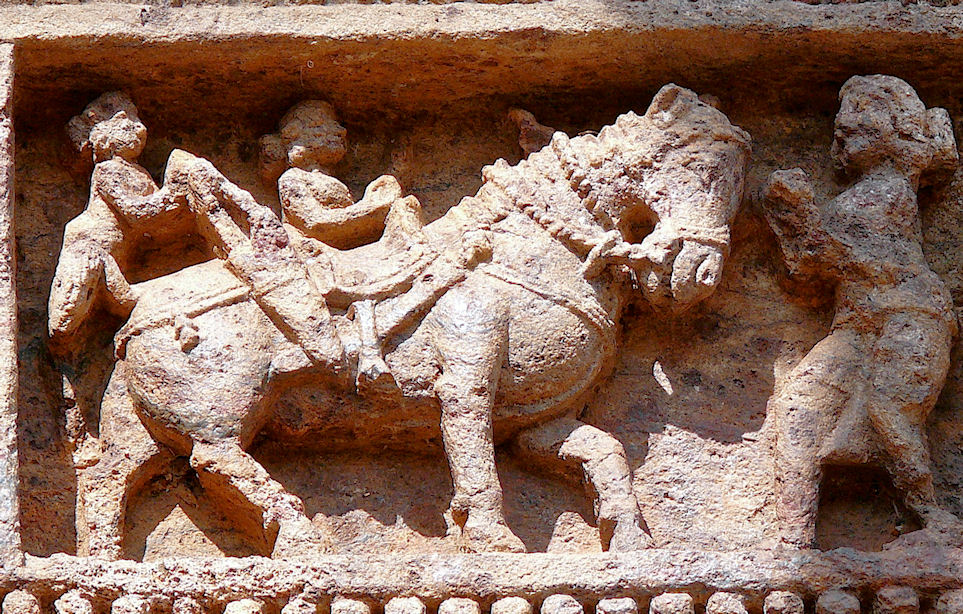
Abb.: अश्वारोहः । Reitpferd, Konark - କୋଣାର୍କ, Orissa, 13.
Jhdt. n. Chr.
[Bildquelle: Rita Willaert. --
http://www.flickr.com/photos/rietje/346805180/. -- Zugriff am
2011-04-13. --
Creative Commons Lizenz (Namensnennung, keine kommerzielle Nutzung)]
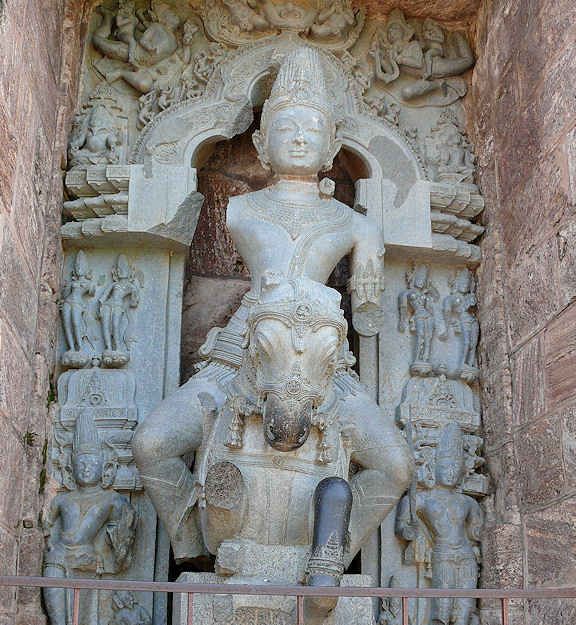
Abb.:
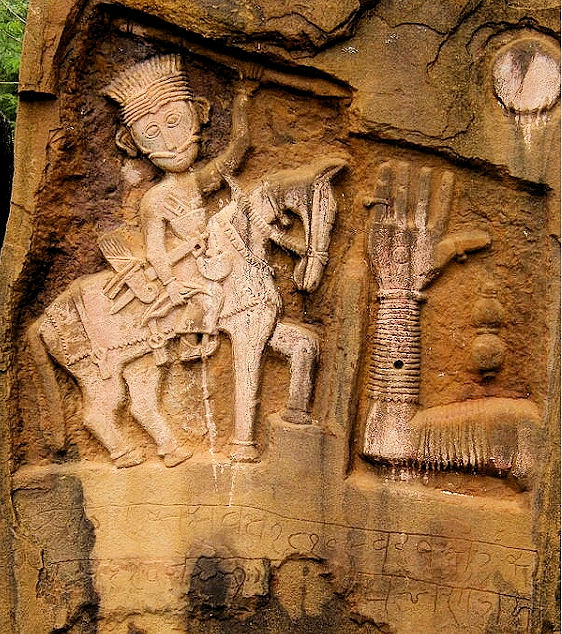
Abb.:
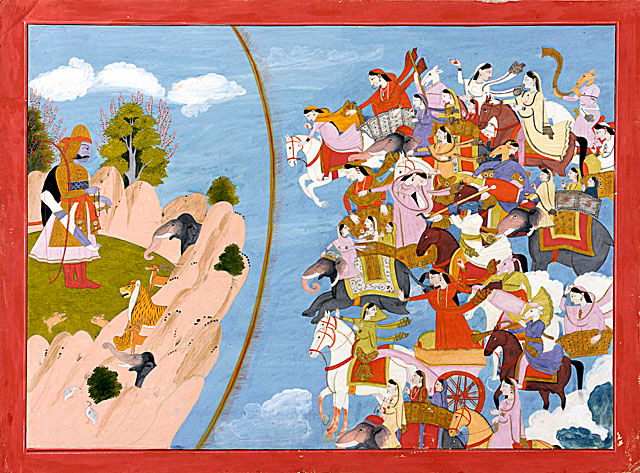
Abb.:
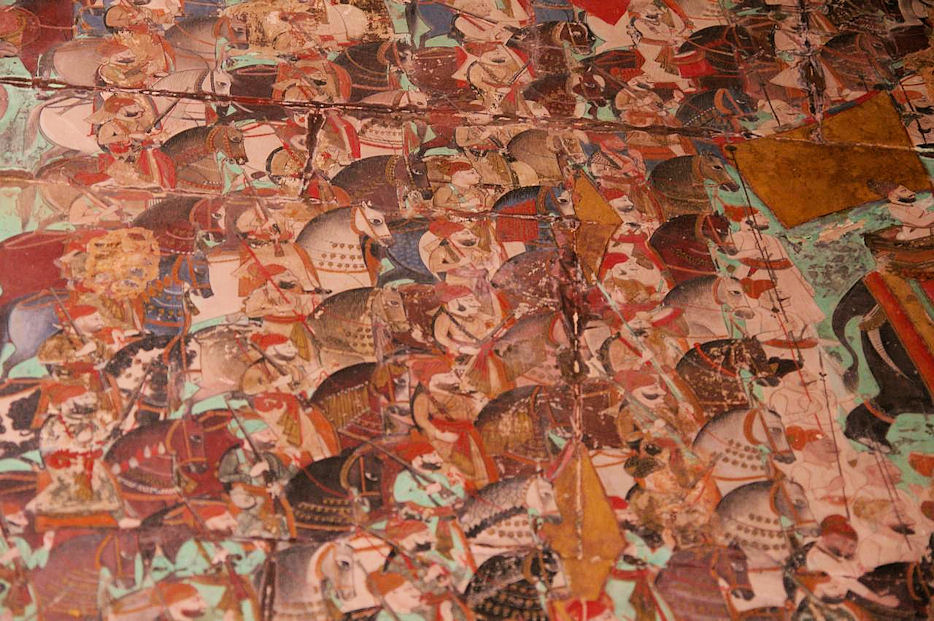
Abb.:
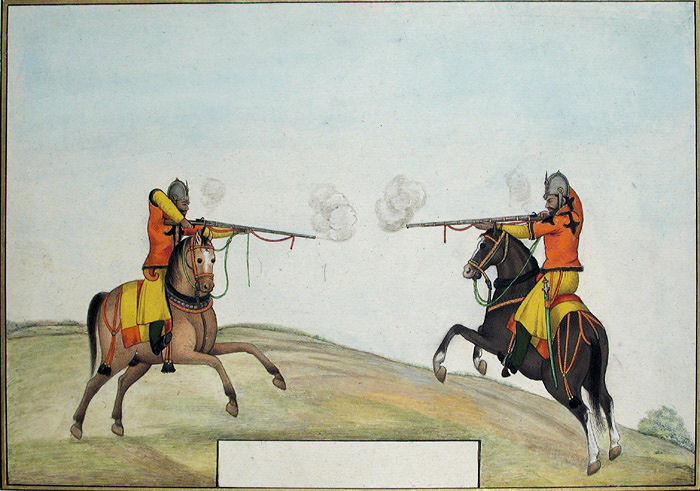
Abb.:
सादिन् - sādin m.: Aufsitzer
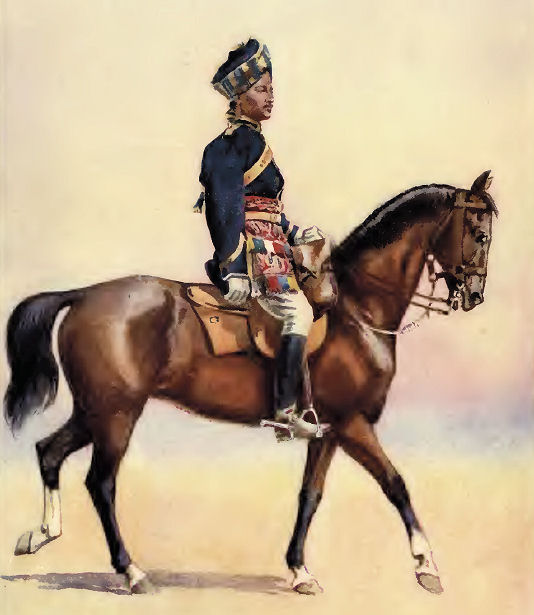
Abb.: सादी । Jemadar (جمعدار) der 12th
Cavalry
[Bildquelle: Lovett, A. C. (Alfred Crowdy) <1862 - 1919> <Painter> ; MacMunn,
G. F. (George Fletcher <1869 - 1952><Text>: The armies of India. -- London,
1911]
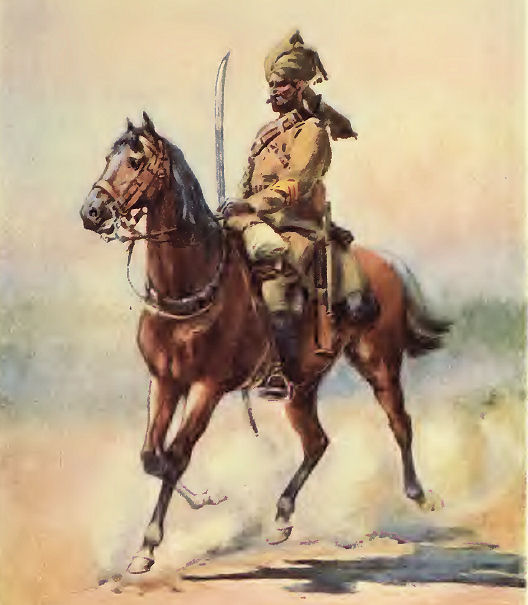
Abb.:
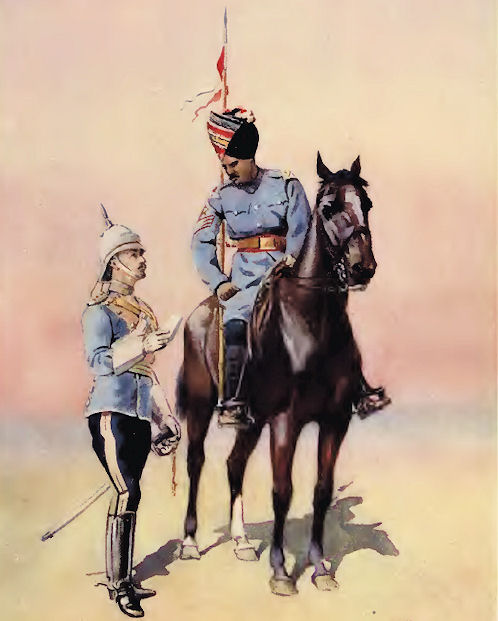
Abb.:
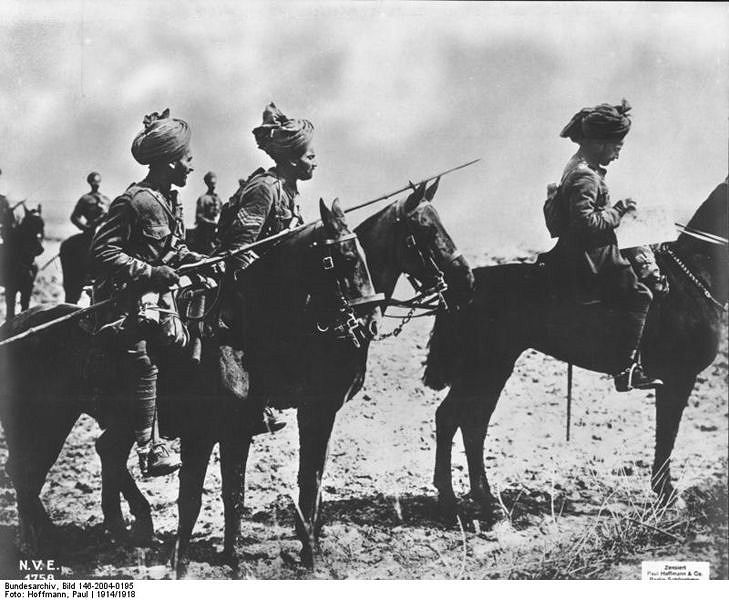
Abb.:
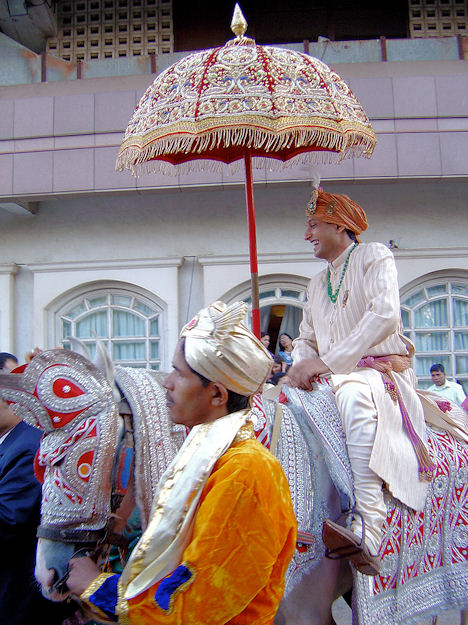
Abb.:
सादी ।
Bräutigam, Mumbai - मुंबई, Maharashtra
[Bildquelle: Sven Lindner. --
http://www.flickr.com/photos/svenlindner/330370495/. -- Zugriff am
2011-04-13. --
Creative
Commons Lizenz (Namensnennung)]
"Cavalry.—I find in the Epic no word corresponding to this heading, but several for 'horse-riders' (aśvāroha, hayāroha, hayārohavara, vājin, sādin), all meaning 'those mounted on a horse.' This fact shows the use of the cavalry. Zimmer says that horse-riding is known to the Vedic age, but finds no mounted cavalry in battle. In the Epic age we have, indeed, cavalry, but unorganized. The mounted soldiers are recognized as a body (kulam) apart from others, of course, but do not act together. They appear as concomitants of the war-cars, dependent groups; but separate horsemen appear everywhere. Their employment was much influenced by that of the elephants. A body of horsemen is routed by an elephant. They were therefore detailed in small numbers to guard the war-cars and keep on the flanks of their own elephants. To the latter, indeed, they are formally assigned, but seem generally to be circling about the chariots.
Horse-back riding is so common, in peace as well as war, that we are rather surprised at the indifferent riding displayed; for the cavalry-men are mainly conspicuous through falling off their horses, quite often from fear alone. They are generally grouped with the hastisādinaḥ or elephant-riders, as a force antithetical to the main strength of the army, the car-men. Thus, two knights drive on their cars 'with horses and horse-riders, as if with rushing swans;' and we read of riders (violating the code!) fighting with the chariot-men, 'piercing their heads.' The verses preceding, with the swan-metaphor, describe the cavalry-horses as carrying plumes and āpīḍa, which the commentator takes for quivers, but which probably means garlands of flowers. The same passage adds the fate of 'many riders of horses' slain by one knight' with well-knotted arrows' (vi. 46. 23).
The horse-riders form a sort of aides-de-camp, and are dispatched with messages by the king, not being ordinary cavalrymen, but knights on horseback attending the monarch.
Although the horse-riders are supposed to attack only their like, they contend with the chariot-men, as we saw above, and fight from rear and side the elephants which they dare not meet face to face; as the 'mountain-beasts,' when maddened by the fight, repeatedly overturn both war-cars and horse and rider together.
In one instance, the horsemen attack the other horsemen with darts, but immediately after they attack a charioteer in the same way. In another case, a knight overthrows car-men from their car and the riders from their horses' backs, more commonly said of the riders.
The horse-riders are the fighters especially spoken of as 'drunk with fighting,' yuddhaśauṇḍa. The arms of the cavalry-men are usually darts only, but we find also spears and knives or short swords used by them.
As the riders fight alone, when killed they fall unnoticed, and their horses run loose, increasing the uproar and confusion (vi. 105.21 ff.). Their most efficient aid was given when they were hurled against the foe after the elephants had become useless, and the throng was too dense and mixed for the employment of war-cars. Then the agile and single horsemen could do good work on the herd of frightened foot-soldiers, unimpeded by fear of heavier foes (so in ix. 23. 60 ft.). The formal and unreal arrangement of the army distributes ten or one hundred mounted horsemen as a guard to each elephant (see below).
The horsemen are represented as falling asleep on their horses' backs when the fight has been continued too long, with the elephant riders and charioteers keeping them company in weariness.
Outside of regular cavalry-men, we find that the chariot-knights and kings often flee on horses when their cars are disabled, and no other refuge presents itself, such as leaping into a friendly car (the common escape) (ix. 25.23).
The horse of the cavalry-man was not driven by a goad, as was the chariot-horse, but by a whip. This (described as gilded) was fastened to the wrist of the rider, leaving his hand free. The whip gives us a figure in describing a fiery-tempered man, 'restless under that word as is a fine horse under the whip.' It is doubtful whether saddles were used; but the bridle and bit are to be assumed, as in the case of the chariot-horse. Probably the frequently-mentioned blankets found on the field served as saddles. The riders wore breast-plates and turbans besides their arms."
[Quelle: Hopkins, Edward W. (Washburn) <1857 - 1932>: The social and military position of the ruling caste in ancient India; as represented by the Sanskrit epic; with an appendix on the status of woman. -- Reprint from the 13th volume of the Journal of the American Oriental Society (1888). -- New Haven, Conn. : Tuttle, 1889. -- S. 262-265]
|
29a./b. bhaṭā yodhāś ca yoddhāraḥ senārakṣās tu sainikāḥ भटा योधाश् च योद्धारः सेनारक्षास् तु सैनिकाः ।२९ क। [Bezeichnungen für Krieger:]
|
Colebrooke (1807): "Warriors generally."
भट - bhaṭa m.: Soldat, Diener, Knecht
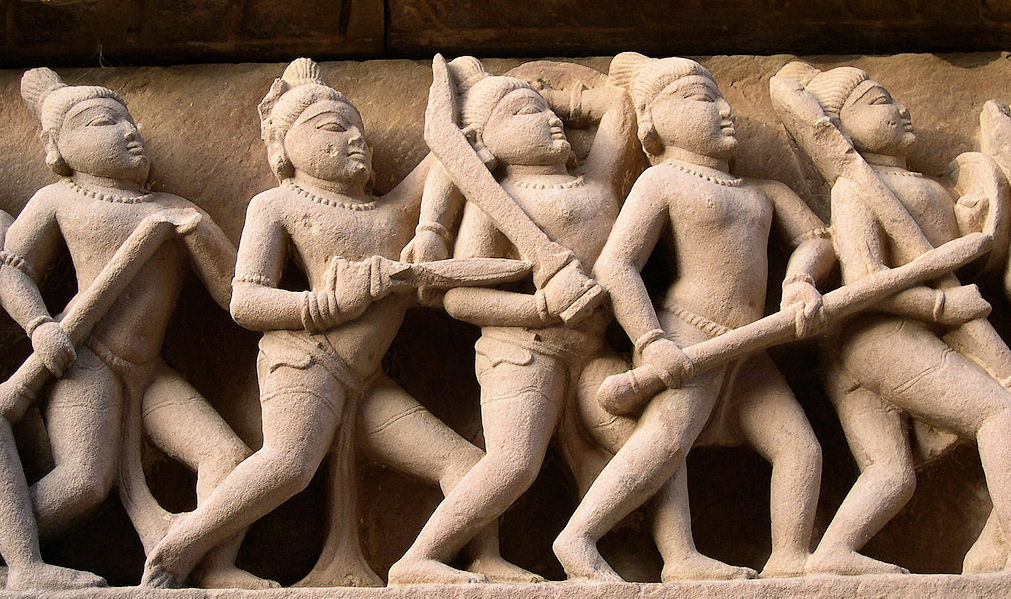
Abb.: भटाः । Krieger /
योध - yodha m.: Kämpfer, Soldat
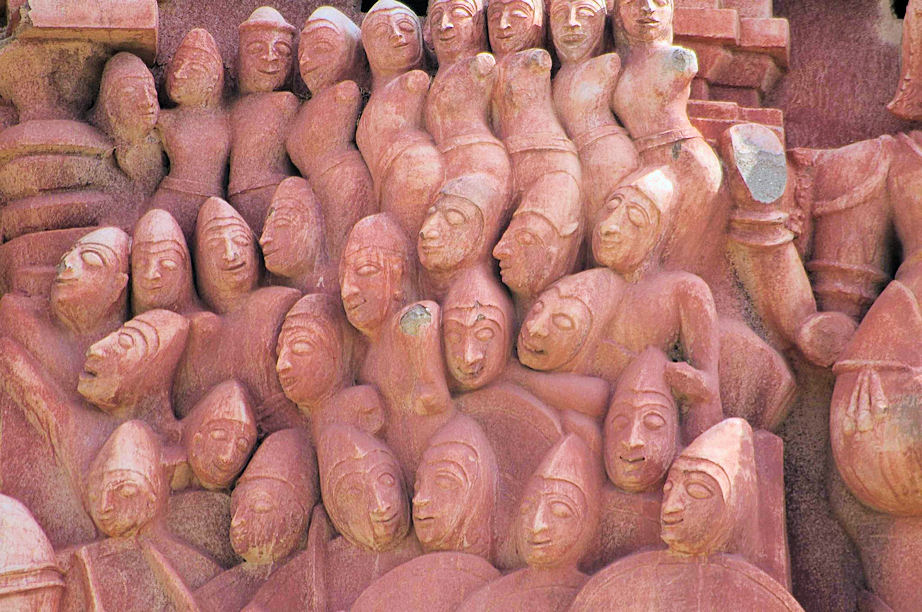
Abb.: योधाः । Krieger, Hampi - ಹಂಪೆ,
Karnataka
[Bildquelle: Andrea Kirkby. --
http://www.flickr.com/photos/andreakirkby/5428086841/. -- Zugriff am
2011-06-08. --
Creative Commons Lizenz (Namensnennung, keine kommerzielle Nutzung)]
योद्धृ - yoddhṛ m.: Kämpfer, Soldat
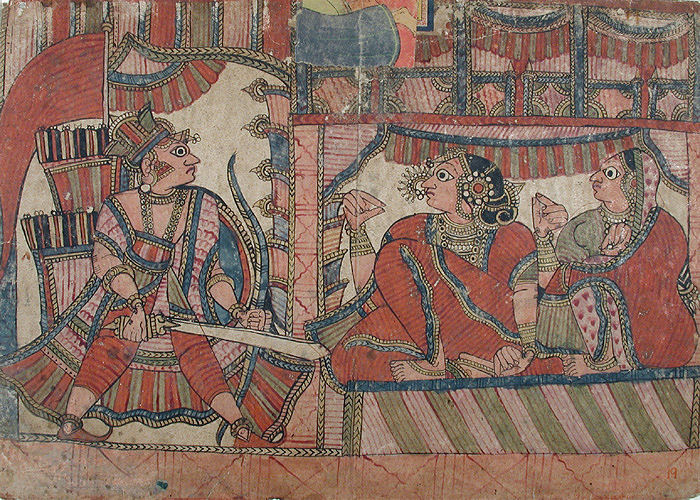
Abb.: योद्धा । Krieger, Maharashtra, 19. Jhdt.
|
29a./b. bhaṭā yodhāś ca yoddhāraḥ
senārakṣās tu sainikāḥ भटा योधाश् च योद्धारः सेनारक्षास् तु सैनिकाः ।२९ क। [Bezeichnungen für Wachposten:]
|
Colebrooke (1807): "Guards or sentinels."
|
29c./d. senāyāṃ samavetā ye sainyās te sainikāś
ca te सेनायां समवेता ये सैन्यास् ते सैनिकाश् च ते ॥२९ ख॥ Die, welche in einem Heer (zur Schlacht) versammelt sind, heißen:
|
Colebrooke (1807): "Arrayed troops."
|
30a./b. balino ye sahasreṇa sāhasrās te
sahasriṇaḥ बलिनो ये सहस्रेण साहस्रास् ते सहस्रिणः ।३० क। Heeresangehörige, die in Tausendschaften sind, heißen:
|
Colebrooke (1807): "A thousand strong."
|
30c./d. paridhisthaḥ paricaraḥ senānīr vāhinīpatiḥ परिधिस्थः परिचरः सेनानीर् वहिनीपतिः ॥३० ख॥ [Bezeichnungen für Wache:]
|
Colebrooke (1807): "A guard or attendant. Bodyguard."
परिधिस्थ - paridhistha m.: im Umkreis Aufgestellte, Wache
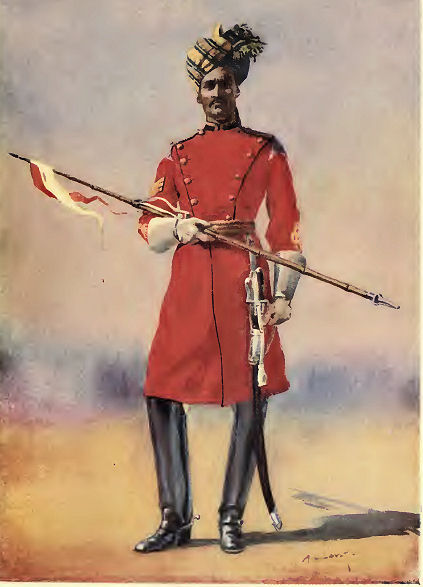
Abb.: परिधिस्थः । Leibwächter des Governor General im Rang eines Daffadar (दफ़्फ़दार)
परिचर - paricara m.: Umhergehender, Diener, Bedienung, Wache
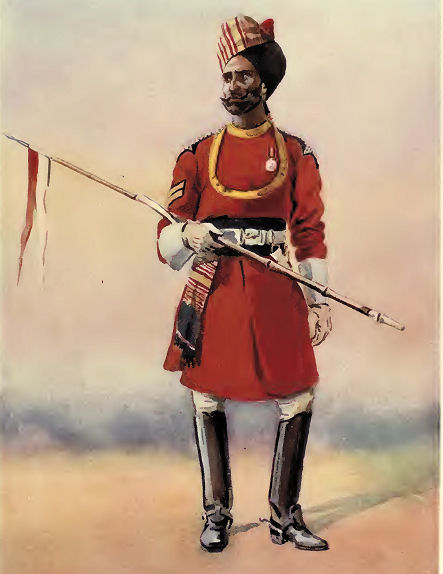
Abb.: परिचरः । Leibwächter des Governor von Madras -
மெட்ராஸ் (heute: Chennai
- சென்னை)
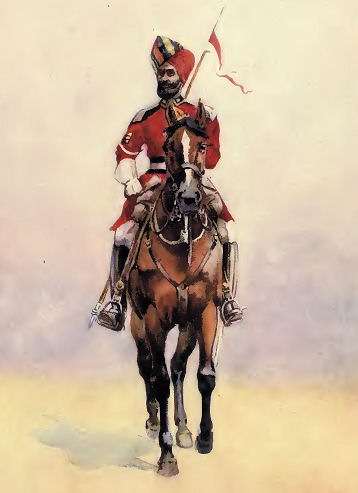
Abb.: परिचरः । Leibwächter des Governor von Bombay (heute: Mumbai - मुंबई)
|
30c./d. paridhisthaḥ paricaraḥ
senānīr vāhinīpatiḥ परिधिस्थः परिचरः सेनानीर् वहिनीपतिः ॥३० ख॥ [Bezeichnungen für Heerführer:]
|
Colebrooke (1807): "A general."
सेनानी - senānī m.: Heerführer, Oberbefehlshaber
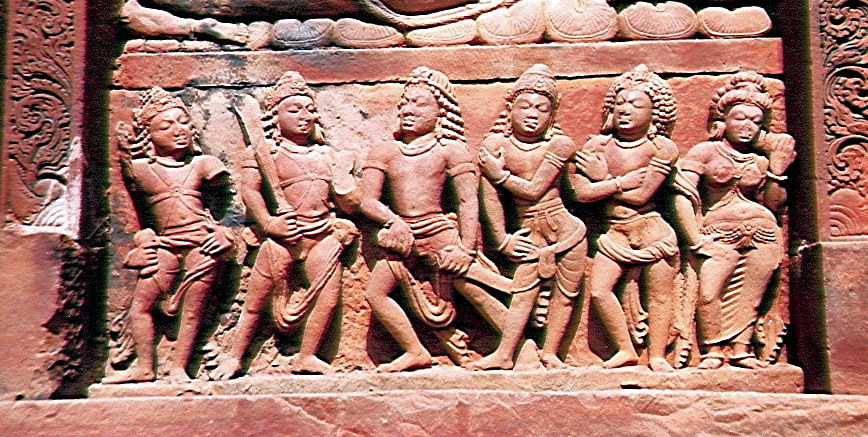
Abb.: सेनान्यः । Die fünf Pāṇḍava mit ihrer Gattin Draupadī, Daśāvatāra-Tempel, Deogarh
- देओगढ़, Uttar
Pradesh
[Bildquelle: vaticanus. --
http://www.flickr.com/photos/vaticanus/2073661803/. -- Zugriff am
2011-04-13. --
Creative
Commons Lizenz (Namensnennung)]
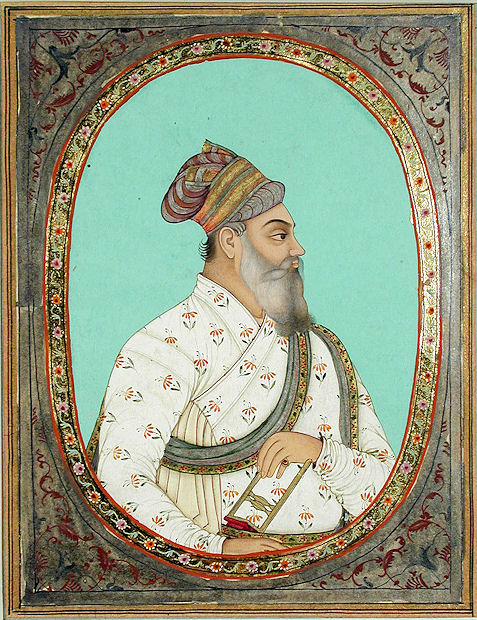
Abb.: सेनानीः । Moghul-General Mirza Ilich Khan, Andhra Pradesh, ca.
1670
[Bildquelle: Asian Curator at The San Diego Museum of
Art. --
http://www.flickr.com/photos/asianartsandiego/4837638275/. -- Zugriff am
2011-04-13. --
Creative Commons Lizenz (Namensnennung, keine kommerzielle Nutzung,
keine Bearbeitung)]
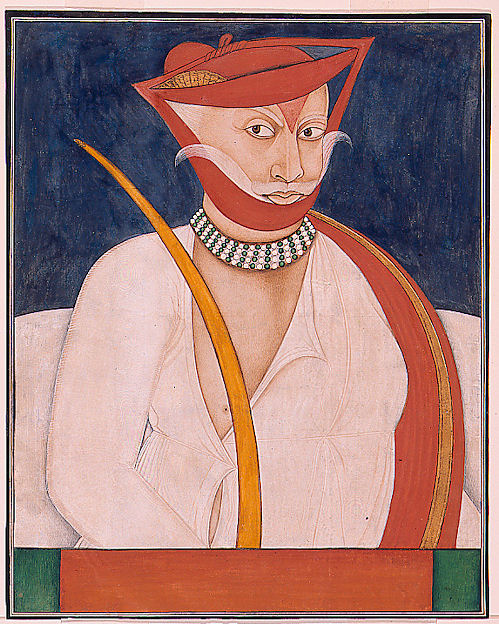
Abb.: सेनानीः । Ram Rao Phalke, General von Jayaji Rao Sindhia, Mahārāja von Gwalior -
ग्वालियर, heute Madhya Pradesh, ca. 1845
[Bildquelle: Asian Curator at The San Diego Museum of
Art. --
http://www.flickr.com/photos/asianartsandiego/4838443250/. -- Zugriff am
2011-04-13. --
Creative Commons Lizenz (Namensnennung, keine kommerzielle Nutzung,
keine Bearbeitung)]
वहिनीपति - vahinīpati m.: Heerführer
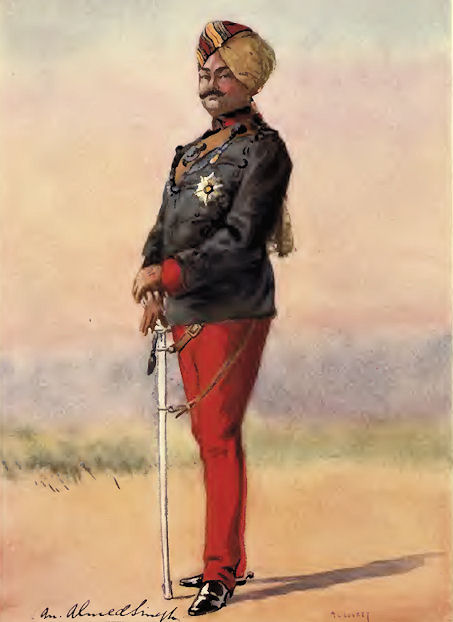
Abb.:
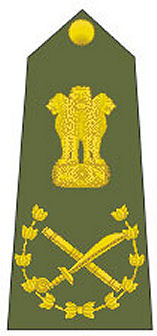
Abb.:
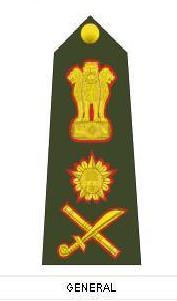
"Ebendies soll der Feldmarschall (senāpati), der in der Wissenschaft von allen Kämpfen und Waffen geschult und in der Fortbewegung zu Elefant, Ross und Wagen vollkommen7 sein muss, kennen: die Pflege und die Leitung des (ganzen) vierteiligen Heeres. Er soll das richtige Auge haben für das günstige Gelände, die Zeit des Kampfes,8 das gegenüberstehende Heer, die Brechung des Ungebrochenen,9 die Wiederherstellung des Gebrochenen, die Brechung des Zusammengeschlossenen, die Vernichtung des Gebrochenen, die Zerstörung der Feindesburgen und die richtige Zeit für einen Feldzug.
Die Zeichen für das in Schlachtordnung aufgestellte Heer, wenn es stillstehen, vorwärtsgehen, einbauen soll, lasse er durch musikalische Instrumente, Standarten und Fahnen geben, freudig bedacht auf das stramme Verhalten seiner Soldaten.10
Fußnoten
7 Gaṇ. hat saṃghuṣṭa, das nur berühmt bedeuten könnte, wie er sagt, sonst aber meines Wissens in dieser Bedeutung nicht belegt ist. Aber auch saṃpuṣṭa ist in außergewöhnlicher Weise gebraucht.
8 Eingeschlossen ist da: er soll sehen, welch eine Art Kampf zu einer bestimmten Zeit der vorteilhafteste ist. Aber wann wird der Sohn des brüllenden Mars namentlich die altindische Weisheit lernen, dass mantrayuddha, der Kampf mit politischer Weisheit, unendlich wertvoller ist als der mit Schwert, Explosionsstoff, Giftgas usw.! Freilich darf man ihn nicht allzustreng tadeln, da sein staatsmännischer Zwillingsbruder nicht einmal Wissen, viel weniger aber wirkliche Weisheit zu besitzen pflegt.
9 Hier weniger wahrscheinlich: »die Veruneinigung der noch Vereinigten«, obschon ja die eigenen Truppen nicht innerlich zusammenhangen dürfen. Aber saṃhata mag sehr wohl auf die eigenen Truppen zielen; saṃhata »zusammengeschlossen, vereinigt, fest zusammenhaltend« kommt mehrfach bei Kauṭ. aber auch im MBh. vor (z.B. V, 125, 25; VI, 160, 75; XII. 270, 10 f.). Also vielleicht doch: »die Veruneinigung der Zusammengeschlossenen.«
10 Nicht so gut: »die durch musikalische Instrumente, Standarten und Fahnen vermittelten Zeichen für die Heerhaufen bestimme er, freudig bedacht auf die Ausbildung und Manneszucht seiner Soldaten, beim Haltmachen, beim Marschieren und beim Angriff«. Vyūha ist eben nicht das Heer auf dem Marsch, noch im Lager, sondern in Schlachtordnung.A3
A3 Eingehend mit dem senāpati oder Feldmarschall beschäftigt sich Kām. XIX, 27ff; Nītiv. 48, 5ff. Zu seinen Tugenden oder Erfordernissen gehört unter anderem: »die verschiedenen Schriftarten und Sprachen kennend, ein Benehmen (ākāra) und einen Leib besitzend, die für die Schlacht und den Umgang mit den Menschen taugen, vom Herrscher ausgezeichnet mit Gütern und fürstlichen Würdezeichen, wie er sie selber besitzt, allen Mühsalen und Anstrengungen gewachsen, von anderen sich nicht einschüchtern lassend.« Zu seinen Fehlern zählt z.B. Eigenmächtigkeit und die Unfähigkeit, den Tricks der Feinde zu begegnen (tantrapratikāra). Siehe auch Śukran. II, 180–190; zur Schlussstrophe des Kapitels Śukran. II, 402 f.; IV, 7, 532f.; 535–550; 735."
[Quelle: Kauṭilya: Das altindische Buch vom Welt- und Staatsleben : das Arthaśāstra des Kauṭilya / [aus dem Sanskrit übersetzt und mit Einleitung und Anmerkungen versehen von] Johann Jakob Meyer [1870-1939]. -- Leipzig, 1926. -- Digitale Ausgabe in: Asiatische Philosophie. -- 1 CD-ROM. -- Berlin: Directmedia, 2003. -- (Digitale Bibliothek ; 94). -- S. 224f.]
| 31a./b. kañcuko vārabāṇo 'strī yat tu madhye sakañcukāḥ कञ्चुको वारबाणो ऽस्त्री यत् तु मध्ये सकञ्चुकाः ।३१ क।[Bezeichnungen für Panzer:]
|
Colebrooke (1807): "Armour ; hauberk."
कञ्चुक - kañcuka m.: "eine eng anschließende Kleidung des Oberkörpers, Panzer, Wams ; Mieder, Jacke" (PW)
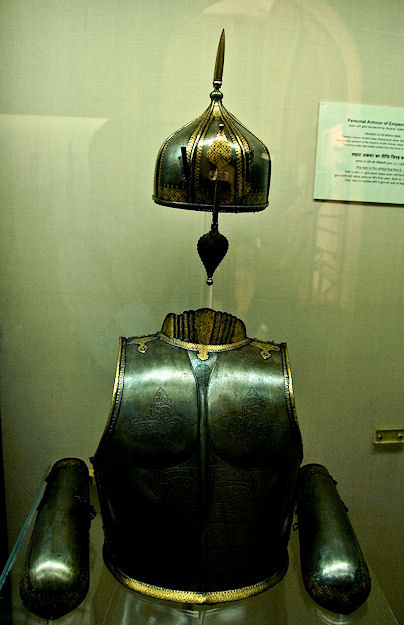
Abb.: कञ्चुकः । Panzer Akbars (1542 - 1605) -
جلال الدین محمد اکبر , Mumbai - मुम्बई, Maharashtra
[Bildquelle: Chrisada Sookdhis. --
http://www.flickr.com/photos/chrisada/2320033409/. -- Zugriff am
2011-04-13. --
Creative
Commons Lizenz (Namensnennung)]
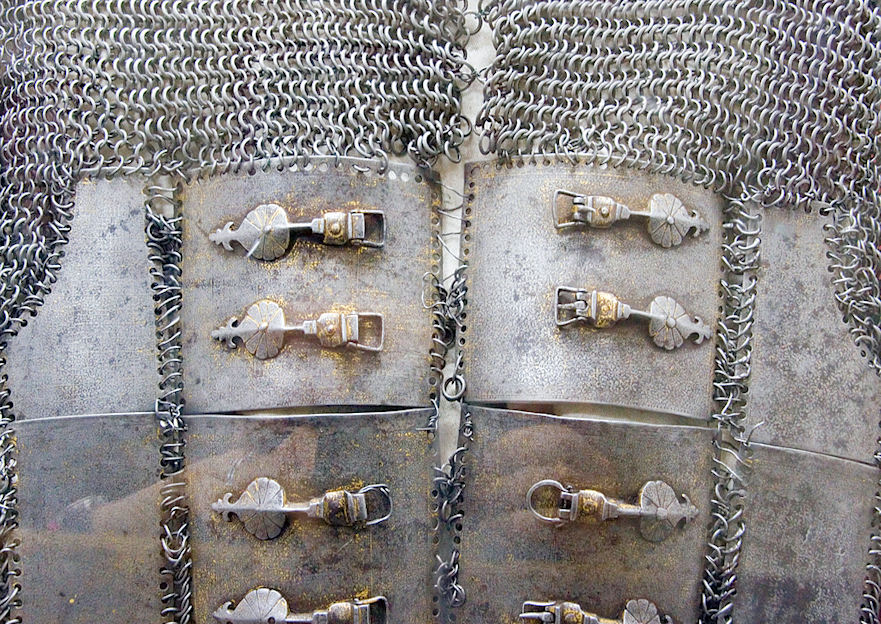
Abb.: कञ्चुकः । Kettenhemd, Udaipur - उदयपुर, Rajasthan
[Bildquelle:
ૐ Dey Alexander ૐ.
--
http://www.flickr.com/photos/dey/1338772736/. -- Zugriff am 2011-04-16.
--
Creative Commons Lizenz (Namensnennung, keine kommerzielle Nutzung,
share alike)]
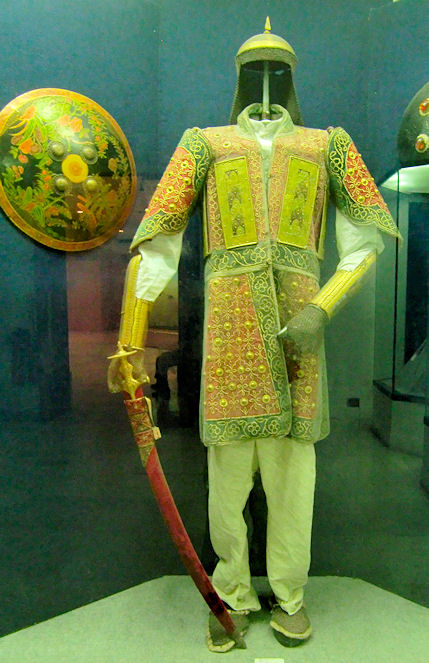
Abb.: कञ्चुकः । Panzer, Rajasthan, 18. Jhdt.
[Bildquelle: miya.m / Wikimedia. -- GNU FDLicense]
वारबाण - vārabāṇa m., n.: "Pfeil-Abwehrer", Panzer, Wams, Jacke
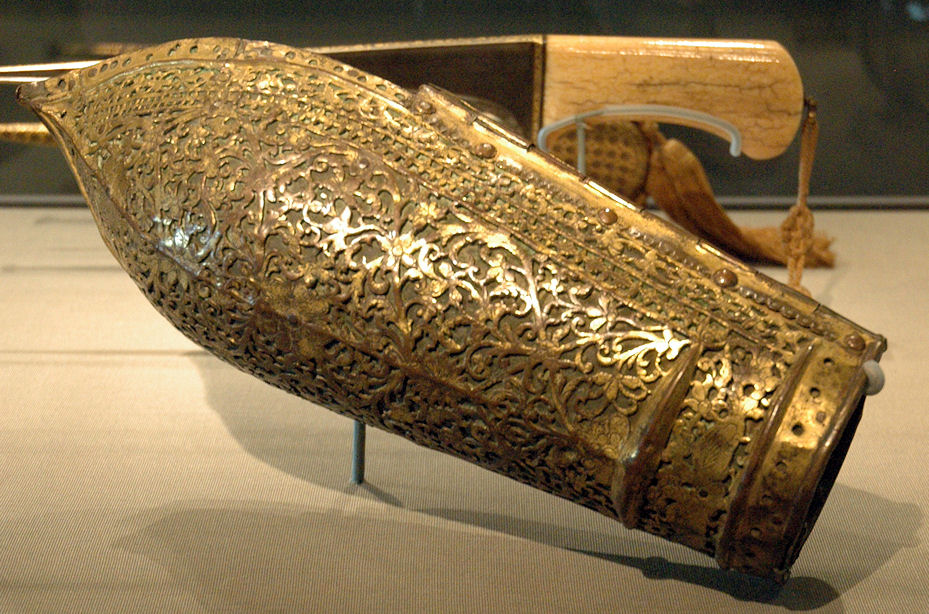
Abb.: वारबाणः । Armpanzer, Indien
[Bildquelle: Marshall Astor. --
http://www.flickr.com/photos/lifeontheedge/246770051/. -- Zugriff am
2011-04-13. --
Creative
Commons Lizenz (Namensnennung, share alike)]
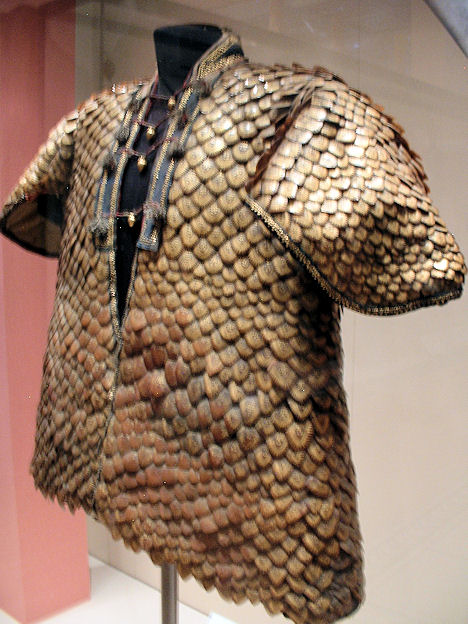
Abb.: वारबाणः । Panzerhemd aus vergoldeten Schuppen des Vorderindischen Schuppentiers
(Manis crassicaudata Gray, 1827), Rajasthan, Beginn 19. Jhdt
[Bildquelle: Gaius Cornelius / Wikimedia. -- Public domain]
| 31a./b. kañcuko vārabāṇo 'strī
yat tu madhye sakañcukāḥ 31c./d. badhnanti tat sārasanam adhikāṅgo 'tha śīrṣakam कञ्चुको वारबाणो ऽस्त्री यत् तु मध्ये सकञ्चुकाः ।३१ क।बध्नन्ति तत् सारसनम् अधिकाङ्गो ऽथ शीर्षकम् ॥३१ ख॥ Das, was Gepanzerte in der Mitte umbinden, heißt:
|
Colebrooke (1807): "The girdle over the coat of mail."
|
31c./d. badhnanti tat sārasanam adhikāṅgo
'tha śīrṣakam 32a./b. śīrṣaṇyaṃ ca śirastre 'tha tanutraṃ varma daṃśanam बध्नन्ति तत्
सारसनाधिकाङ्गो
ऽथ शीर्षकम् ॥३१ ख॥ Bezeichnungen für Helm (शिरस्त्र - śirastra n.: Kopfschutz, Helm):
|
Colebrooke (1807): "A helmet."
शिरस्त्र - śirastra n.: Kopfschutz, Helm
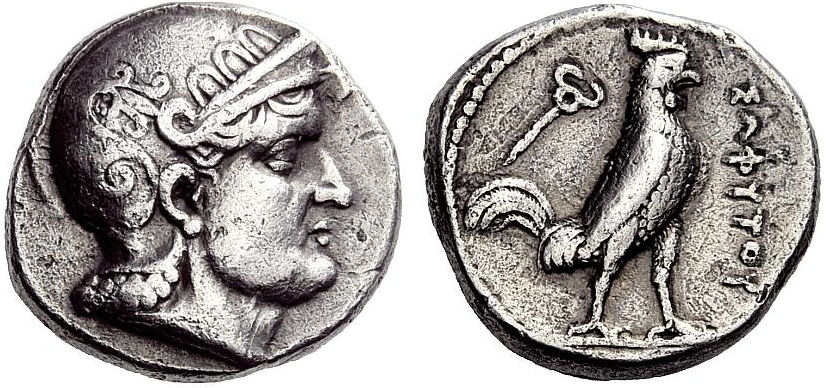
Abb.: शिरस्तम् । Der baktrische König Sophites (ΣΩΦΥΤΗΣ) mit
Helm, ca. 300 v. Chr.
[Bildquelle: Ancient Art. --
http://www.flickr.com/photos/antiquitiesproject/5495637271/. -- Zugriff
am 2011-04-13. --
Creative
Commons Lizenz (Namensnennung)]
शीर्षक - śīrṣaka n.: zum Kopf Gehöriges, Helm
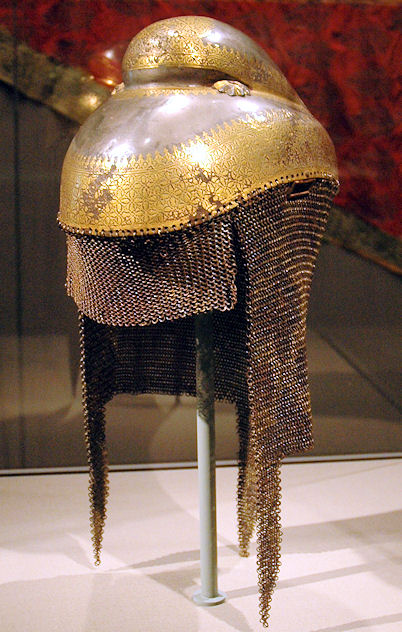
Abb.: शीर्षकम् । Sikh-Helm
शीर्षण्य - śīrṣaṇya n.: am Kopf Befindliches, Kopfkissen, Helm
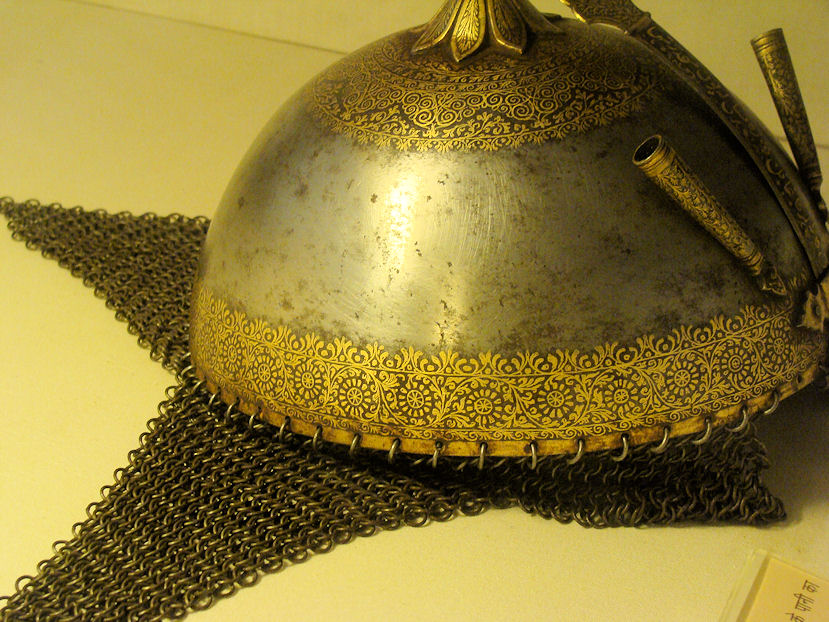
Abb.: शीर्षण्यम् । Helm, Jodhpur, Rajasthan
[Bildquelle: clara & james. --
http://www.flickr.com/photos/clara/2148509260/. -- Zugriff am
2011-04-13. --
Creative
Commons Lizenz (Namensnennung, keine kommerzielle Nutzung, share alike)]
"The helmet (śirastrāṇa, ' head protector', with the kirīṭa, as part for whole) is represented to be of metal and adorned with gems, chiefly the diamond; but, though often spoken of, can get no definite idea of it, from the lack of description in the Epic. It is worn over the ear-rings (R. vi. 78.16). The little towers called nirvyūhas figure apparently as helmets, and must have been (in accordance with the name, which is elsewhere applied to the real towers of a city) high headpieces, perhaps a kind of tiara; but they are essentially practical, not ornamental. The commentator defines the word as a weapon. There was a band of cloth, turban, called uṣṇīṣa or veṣṭana, which was worn with the helmet. I hence suppose that the turban was wound around the sides of the head to guard what a not very well made helm left unprotected. But often the turban is the only head-gear.
The head with helm and earrings 'looks like a full moon'; but the general brilliancy of ornament, not the shape of the head-piece, must be the tertium (viii. 51.13). Brazen, kāṃsya, implies brass used quite as much for adornment as for use; and it is quite possible therefore, that mention of brazen arms must be classed in the same category as that of golden."
[Quelle: Hopkins, Edward W. (Washburn) <1857 - 1932>: The social and military position of the ruling caste in ancient India; as represented by the Sanskrit epic; with an appendix on the status of woman. -- Reprint from the 13th volume of the Journal of the American Oriental Society (1888). -- New Haven, Conn. : Tuttle, 1889 -- S. 306f.]
|
32a./b.
śīrṣaṇyaṃ ca śirastre 'tha tanutraṃ
varma daṃśanam 32c./d. uraśchadaḥ kaṅkaṭako jāgaraḥ kavaco 'striyām
शीर्षण्यं च शिरस्त्रे
ऽथ तनुत्रं वर्म दंशनम् । [Bezeichnungen für Rüstung:]
|
Colebrooke (1807): "Mail."
तनुत्र - tanutra n.: Körperschutz, Panzer, Harnisch
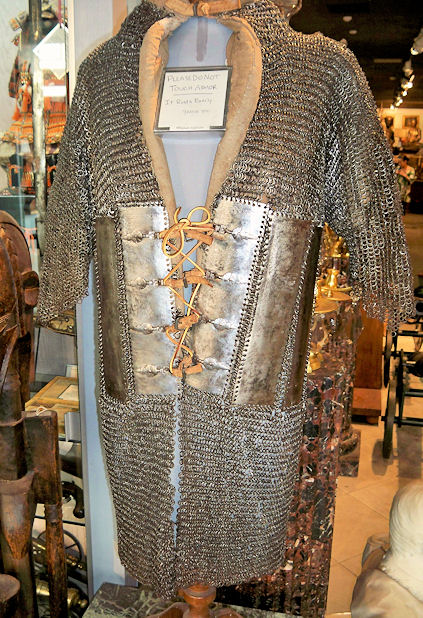
Abb.: तनुत्रम् । Moghul-Kettenrüstung
[Bildquelle: Samuraiantiqueworld / Wikimedia. -- GNU FDLicense]
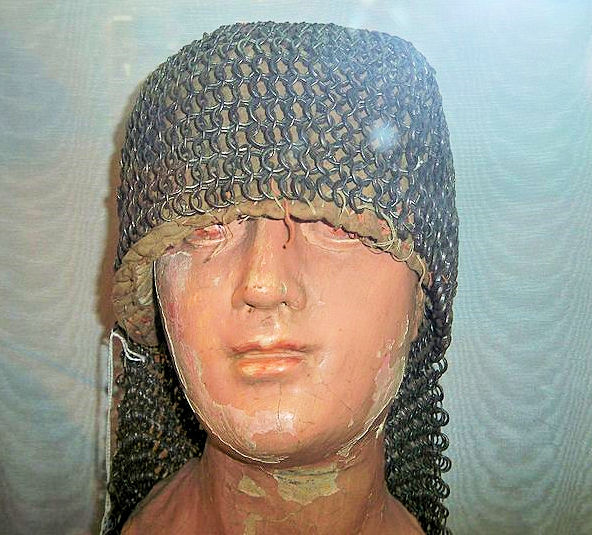
"Varman and kavaca are the usual names of the body-armor. This is sometimes termed ' body-guard' (tanutra, -trāṇa), but is elsewhere the particular breast-guard of the whole armor of man or beast, as 'body-guard.' Another name for this is gātrāvaraṇāni, ' limb-guards,' distributively, equivalent to the collective.
Specific ornamentation is found in the rich descriptions of the fourth book. The armor is here adorned with suns and moons, etc. In this passage, and passim, the cuirass is lauded as impregnable; the nivātakavaca, 'invulnerable plate,' is always assumed. But the knights are in reality perpetually unharnessed (aikavaca), from the armor being either hewn off or becoming loose,.
Varman, generally iron, and carman, leather armor, are often mentioned together. Of metals, by far the commonest is iron. Of hide, we find a bull's hide, and loose bear-skins (with a brass breastplate), but the latter are generally for shields. Netted armor or wire netting may be meant in jāla, which is adorned with gold and worn by beasts and men. Varman means 'cover,' and carman 'skin.' Hence varman may often imply carman. The fixed phrase khaḍgaṃ carrna tathā gṛhya seem to point to the hide-shield as earlier—an a priori commonplace. As the Yavanas are expressly noted for wearing brass and iron breastplates carefully worked, it is interesting to observe that even these are said to be of such fragile nature as to be easily pierced by a mass of arrows drawn full to the ear."
[Quelle: Hopkins, Edward W. (Washburn) <1857 - 1932>: The social and military position of the ruling caste in ancient India; as represented by the Sanskrit epic; with an appendix on the status of woman. -- Reprint from the 13th volume of the Journal of the American Oriental Society (1888). -- New Haven, Conn. : Tuttle, 1889 -- S. 304f.]
| 33a./b. āmuktaḥ pratimuktaś ca
pinaddhaś cāpinaddhavat आमुक्तः प्रतिमुक्तश् च पिनद्धश् चापिनद्धवत् ।३३ क। [Bezeichnungen für gerüstet, gekleidet:]
|
Colebrooke (1807): "Clothed, or accoutred."
आमुक्त - āmukta 3: angezogen, gekleidet
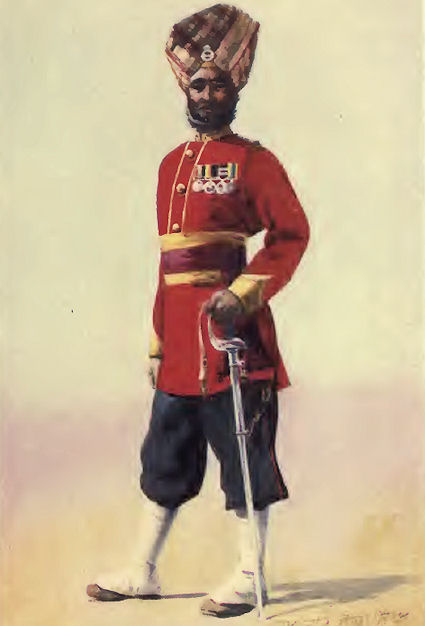
Abb.: आमुक्तः । Subadar der 35th Sikhs
[Bildquelle: Lovett, A. C. (Alfred Crowdy) <1862 - 1919> <Painter> ; MacMunn,
G. F. (George Fletcher <1869 - 1952><Text>: The armies of India. -- London,
1911]
प्रतिमुक्त - pratimukta 3: angezogen, gekleidet
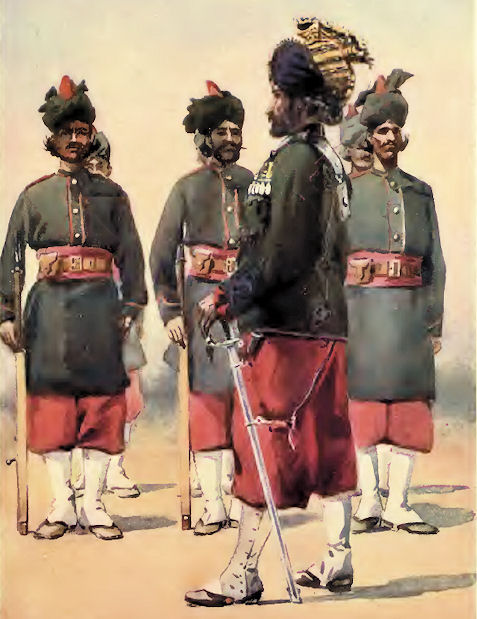
Abb.: प्रतिमुक्ताः । 127th Queen Mary's Own Baluch Light Infantry
पिनद्ध - pinaddha 3: umbunden, angezogen
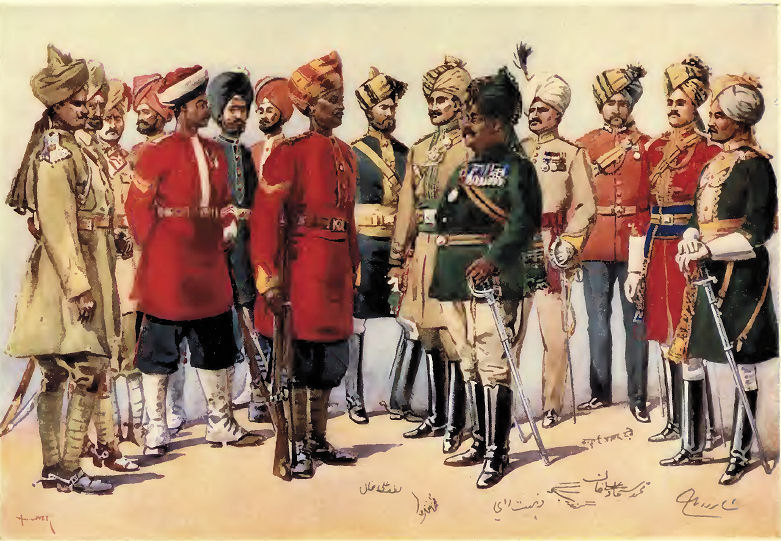
Abb.: पिनद्धाः । Imperial Service Troops
अपिनद्ध - apinaddha 3 und ähnliche Bildungen (zu nah): umbunden, angezogen
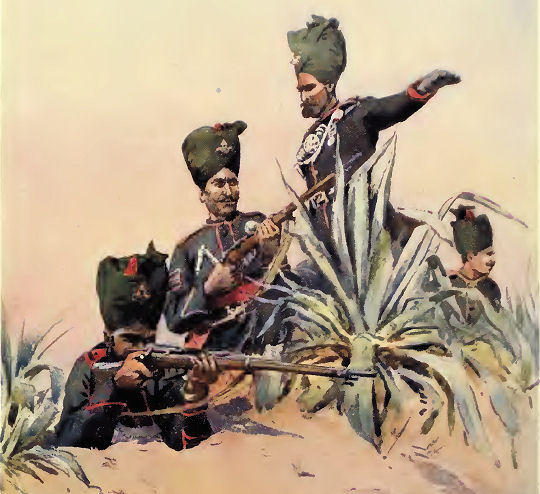
Abb.: अपिनद्धाः । 125th Napier's Rifles
[Bildquelle: Lovett, A. C. (Alfred Crowdy) <1862 - 1919> <Painter>
; MacMunn, G. F. (George Fletcher <1869 - 1952><Text>: The armies of India. --
London, 1911]
|
33c./d. saṃnaddho varmitaḥ sajjo daṃśito
vyūḍhakaṅkaṭaḥ 34a./b. triṣv āmuktādayo varmabhṛtāṃ kāvacikaṃ gaṇe
संनद्धो वर्मितः सज्जो दंशितो व्यूढकङ्कटः ॥३३ ख॥ [Bezeichnungen für gerüstet:]
āmukta (Vers 33a) und die folgenden Wörter sind Adjektive. |
Colebrooke (1807): "Armed or mailed."
संनद्ध - saṃnaddha 3: umbunden, angezogen
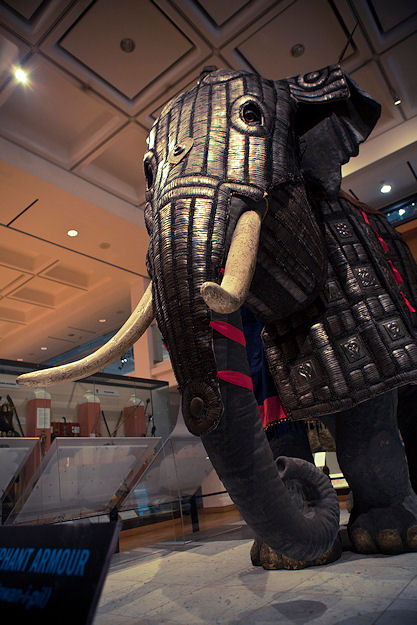
Abb.: संनद्धो गजः । Nord Indien, 16./17. Jhdt.
[Bildquelle: Royal Armouries. --
http://www.flickr.com/photos/royalarmouries/5532376244/. -- Zugriff am
2011-06-09. -- Creative Commons Lizenz (Namensnennung, keine kommerzielle
Nutzung, keine Bearbeitung)]
वर्मित - varmita 3: gepanzert, geharnischt, gerüstet
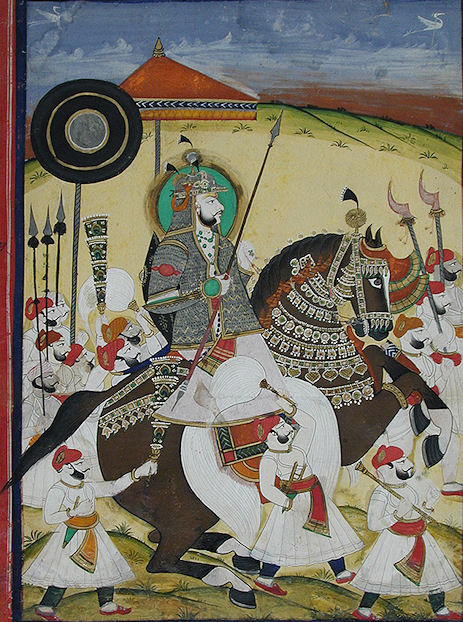
Abb.: वर्मितः । Ram Singh in Panzer, Rajasthan, ca. 1865
सज्ज - sajja 3: bereit (zur Schlacht), fertig
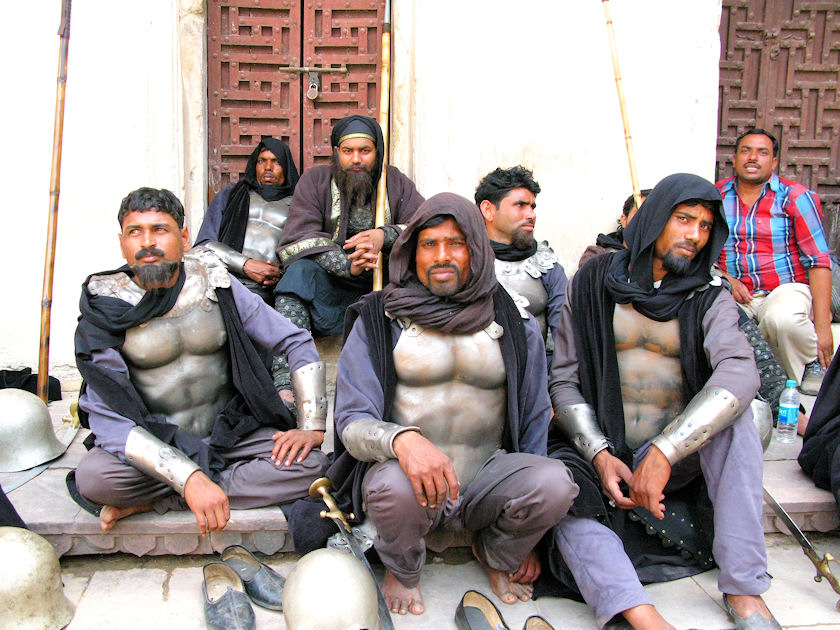
Abb.: सज्जाः । Statisten für Filmaufnahme, Orccha - ओरछा, Madhya Pradesh
[Bildquelle: Rene Passet. --
http://www.flickr.com/photos/passetti/5626473701/. -- Zugriff am
2011-06-09. --
Creative Commons Lizenz (Namensnennung, keine kommerzielle Nutzung,
keine Bearbeitung)
व्यूढकङ्कट - vyūḍhakaṅkaṭa 3: mit ausgebreitetem Panzer, gepanzert
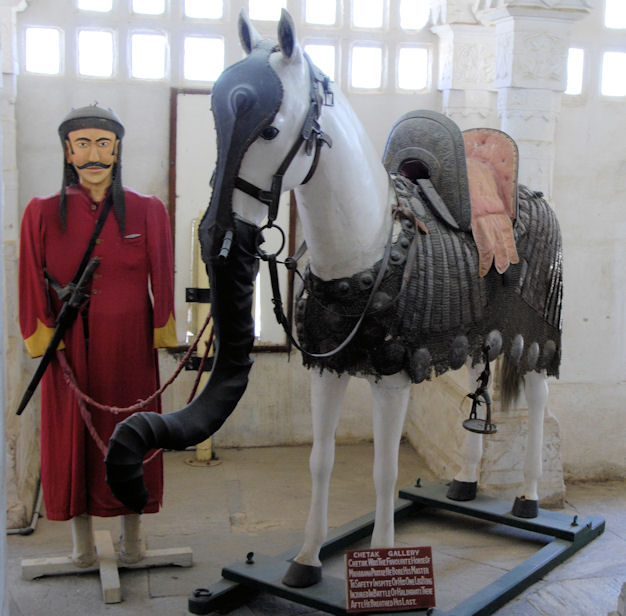
Abb.: व्यूढकङ्कटो
|
34a./b. triṣv āmuktādayo
varmabhṛtāṃ kāvacikaṃ gaṇe त्रिष्व् आमुक्तादयो वर्मभृतां कावचिकं गणे ।३४ क। Eine Truppe von Rüstungsträgern heißt कावचिक - kāvacika n.: Truppe von Geharnischten |
Colebrooke (1807): "Multitude of soldiers mailed."
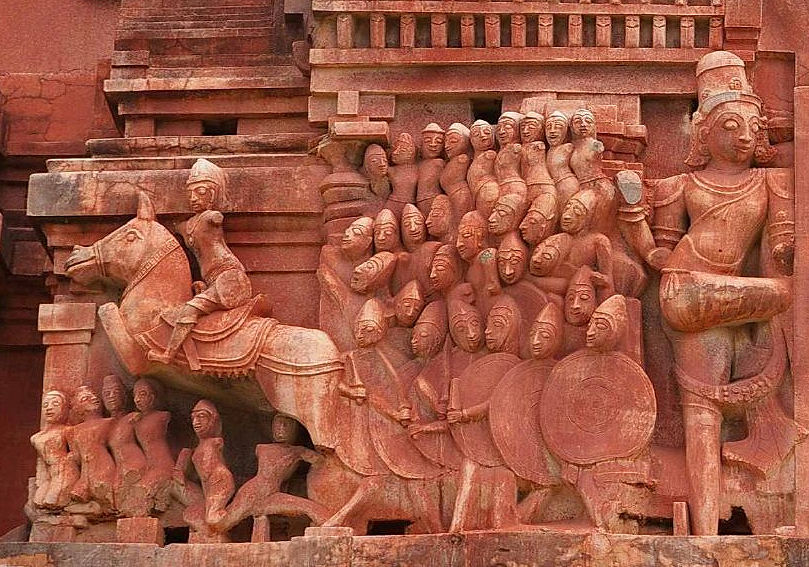
Abb.: कावचिकम् ।
|
34c./d. padāti-patti-padaga-pādātika-padātayaḥ 35a./b. padgaś ca padikaś cātha pādātaṃ pattisaṃhatiḥ
पदाति-पत्ति-पदग-पादातिक-पदात्यः ॥३४ ख॥ [Bezeichnungen für Fußsoldat:]
|
Colebrooke (1807): "A foot-soldier."
पदाति - padāti m.: Fußgänger, Fußsoldat, Infanterist
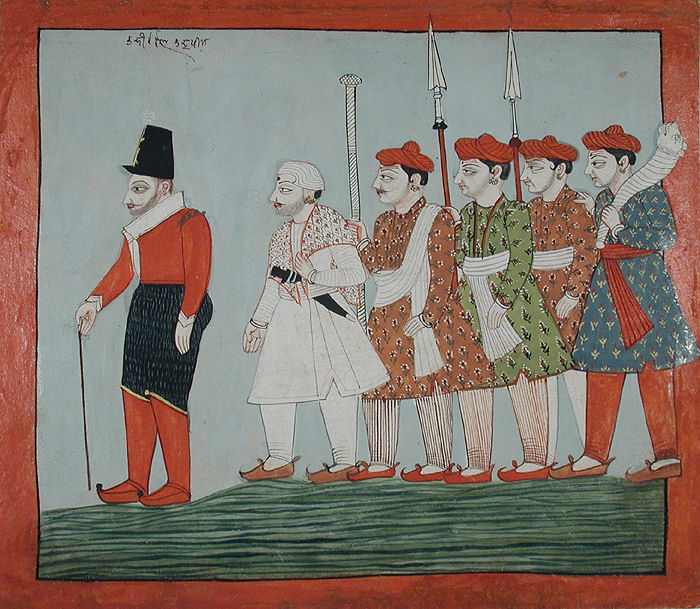
Abb.: पदातयः । Europäer begleitet von Fußsoldaten, Himachal Pradesh, ca. 1820
[Bildquelle: Asian Curator at The San Diego Museum of
Art. --
http://www.flickr.com/photos/asianartsandiego/4837861911/. -- Zugriff am
2011-04-14. --
Creative Commons Lizenz (Namensnennung, keine kommerzielle Nutzung,
keine Bearbeitung)]
पत्ति - patti m.: Fußgänger, Fußsoldat, Infanterist
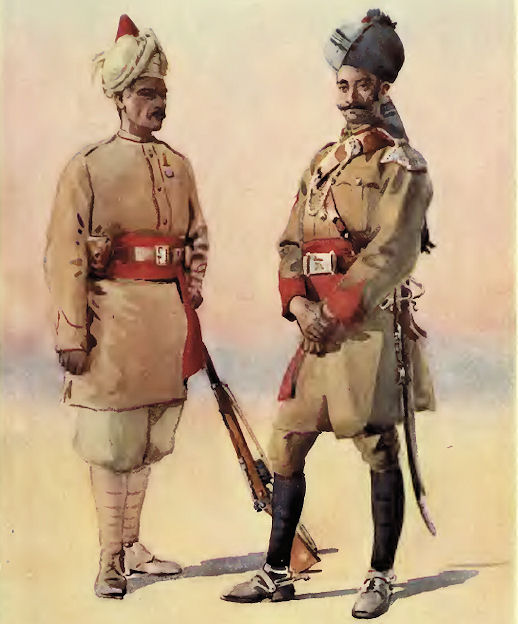
Abb.: पत्तिअश्वारोहश्च । Queen's Own Corps of Guides (links: Infantry, rechts: Cavalry)
[Bildquelle: Lovett, A. C. (Alfred Crowdy) <1862 - 1919> <Painter> ; MacMunn,
G. F. (George Fletcher <1869 - 1952><Text>: The armies of India. -- London,
1911]
पदग - padaga m.: Fußgänger, Begleiter, Fußsoldat, Infanterist
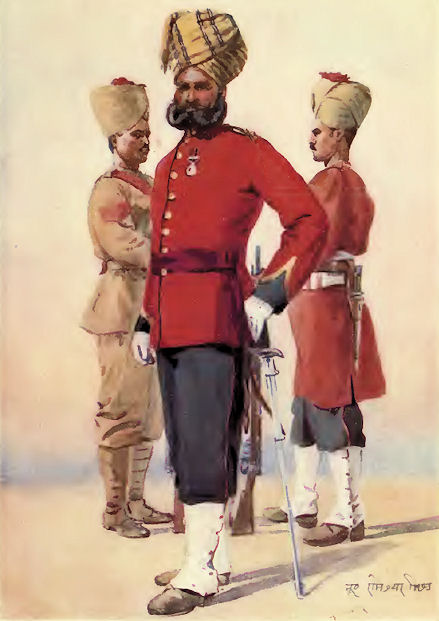
Abb.: पदगाः । Subadar of 1st and 3rd Brahmans (!)
[Bildquelle: Lovett, A. C. (Alfred Crowdy) <1862 - 1919> <Painter> ; MacMunn,
G. F. (George Fletcher <1869 - 1952><Text>: The armies of India. -- London,
1911]
पादातिक - pādātika m.: zu den Fußsoldaten Gehöriger, Infanterist
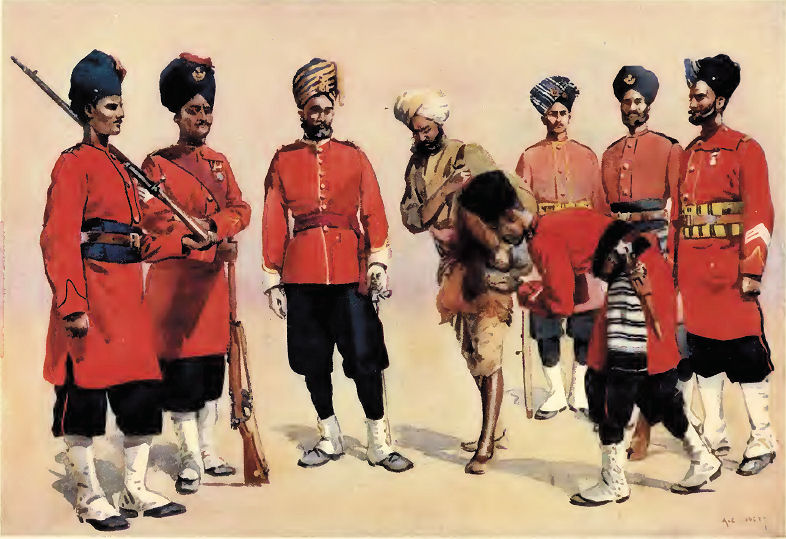
Abb.: पादातिकाः । Rajput-Regimenter
[Bildquelle: Lovett, A. C. (Alfred Crowdy) <1862 - 1919> <Painter> ; MacMunn,
G. F. (George Fletcher <1869 - 1952><Text>: The armies of India. -- London,
1911]
पद्ग - padga m.: Fußgänger, Fußsoldat, Infanterist
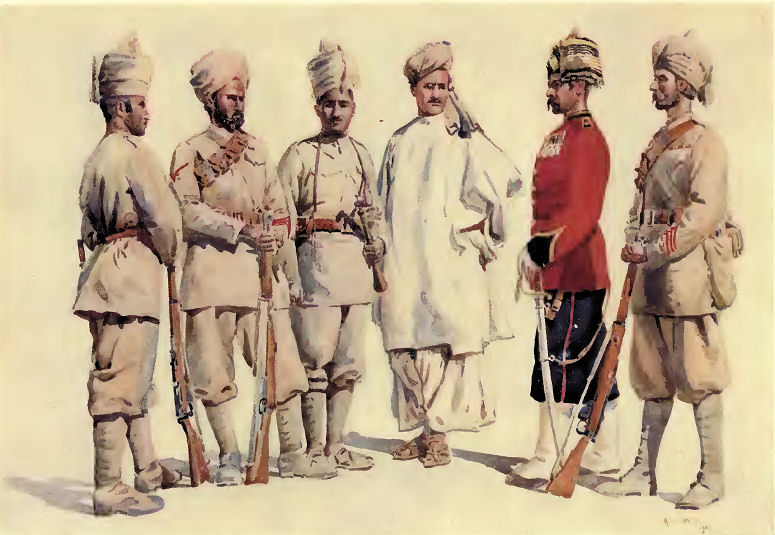
Abb.: पद्गाः । 19th Punjabis
[Bildquelle: Lovett, A. C. (Alfred Crowdy) <1862 - 1919> <Painter> ; MacMunn,
G. F. (George Fletcher <1869 - 1952><Text>: The armies of India. -- London,
1911]
पदिक - padika m.: Fußgänger, Fußsoldat, Infanterist
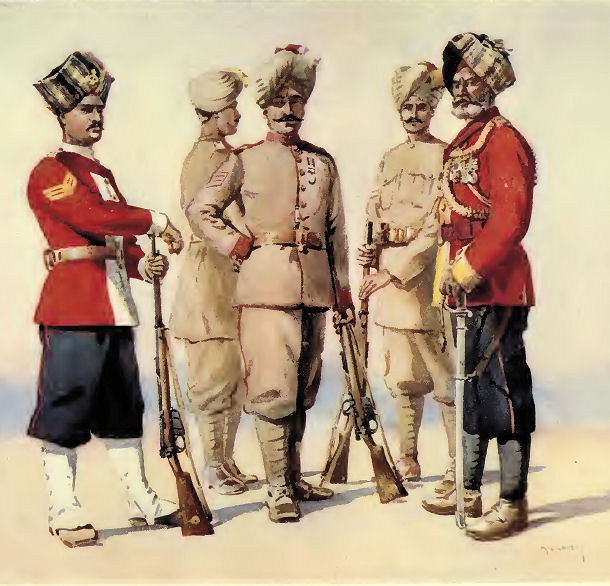
Abb.: पदिकाः । Dogras (ڈوگرا)
[Bildquelle: Lovett, A. C. (Alfred Crowdy) <1862 - 1919> <Painter> ; MacMunn,
G. F. (George Fletcher <1869 - 1952><Text>: The armies of India. -- London,
1911]
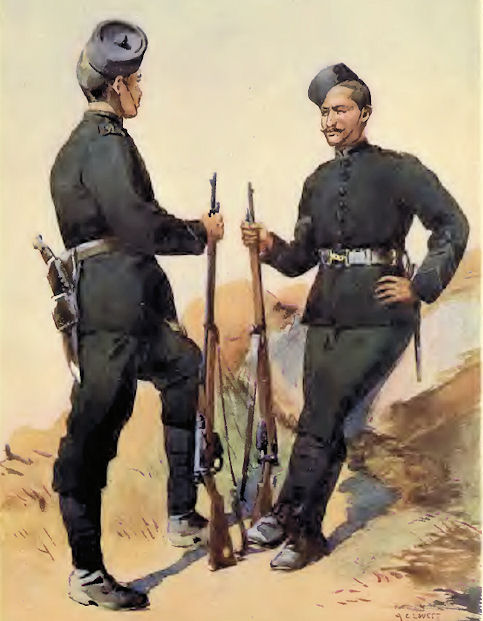
Abb.: पदिकौ । 39th Garhwal (गढ़वाल) Rifles
[Bildquelle: Lovett, A. C. (Alfred Crowdy) <1862 - 1919> <Painter> ; MacMunn,
G. F. (George Fletcher <1869 - 1952><Text>: The armies of India. -- London,
1911]
"Damit ist auch das Nötige über den Fußsoldatenaufseher gesagt. Er soll die Vorzüglichkeit (die Stärke) und die Minderwertigkeit der ererbten, der um Sold angeworbenen, der aus Verbänden bestehenden, der von Bundesgenossen kommenden, der dem Feinde abgenommenen und der Waldstammtruppen kennen.4 Er soll vertraut sein mit der körperlichen Kraftbetätigung (vyāyāma) beim Kampf in Niederungen und auf höher gelegenem, trockenem Gelände, im offenen Streite und im hinterlistigen, unten in Gräben und droben aus der Luft,5 am Tage und in der Nacht; ebenso mit der richtigen Verwendung (der einzelnen Truppen, Kämpfer, Tiere, Waffen usw.) zu den einzelnen Aufgaben und mit der falschen Verwendung.6" Fußnoten
4 Dies sind die sechs verschiedenen Gattungen von Soldaten oder Truppen. Mit Ausschluss der vom Feinde stammenden werden sie z.B. auch MBh. XV, 7, 7 f. genannt. Śreṇībala bedeutet die aus Kriegerverbänden bestehenden Truppen.
5 »Von Stadtmauern usw. herab.« Gaṇ.A2
6 Also damit: die Brauchbarkeit oder die Unbrauchbarkeit zu diesem oder zu jenem.
A2 Richtig aber wohl nur: »in offenem Felde« (ākāśa)."
[Quelle: Kauṭilya: Das altindische Buch vom Welt- und Staatsleben : das Arthaśāstra des Kauṭilya / [aus dem Sanskrit übersetzt und mit Einleitung und Anmerkungen versehen von] Johann Jakob Meyer [1870-1939]. -- Leipzig, 1926. -- Digitale Ausgabe in: Asiatische Philosophie. -- 1 CD-ROM. -- Berlin: Directmedia, 2003. -- (Digitale Bibliothek ; 94). -- S. 224]
| 35a./b.
padgaś ca padikaś cātha pādātaṃ
pattisaṃhatiḥ पद्गश् च पदिकश् चाथ पादातं पत्तिसंहतिः ।३५ क। [Bezeichnungen für eine Truppe von Fußsoldaten:]
|
Colebrooke (1807): "Infantry."
पादात - pādāta n.: Fußtruppe, Angehöriger einer Fußtruppe
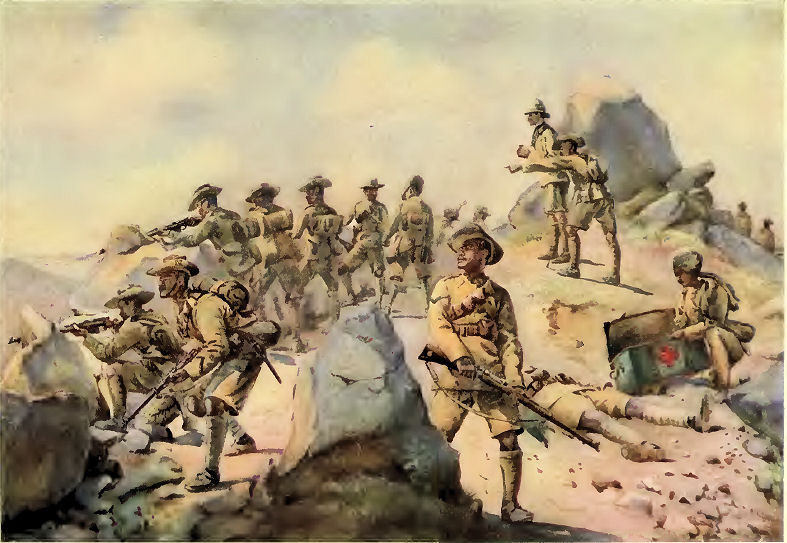
Abb.: पादातम् । Gurkha (गोर्खा) Rifles
[Bildquelle: Lovett, A. C. (Alfred Crowdy) <1862 - 1919> <Painter> ; MacMunn,
G. F. (George Fletcher <1869 - 1952><Text>: The armies of India. -- London,
1911]
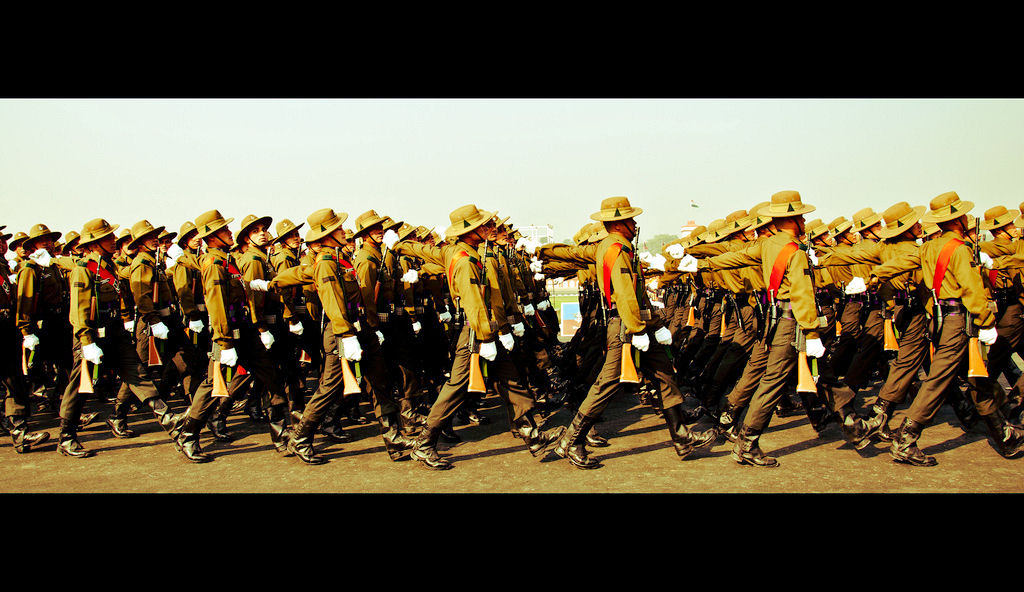
Abb.: पादातम् । Gurkha-Regiment (गोर्खा)
der Indischen Armee, Delhi
[Bildquelle:
Jaskirat Singh
Bawa. --
http://www.flickr.com/photos/jzsinr/5376686125/. -- Zugriff am
2011-04-15. --
Creative Commons Lizenz (Namensnennung, keine Bearbeitung)]
पत्तिसंहति - pattisaṃhati f.: Trupp von Fußsoldaten
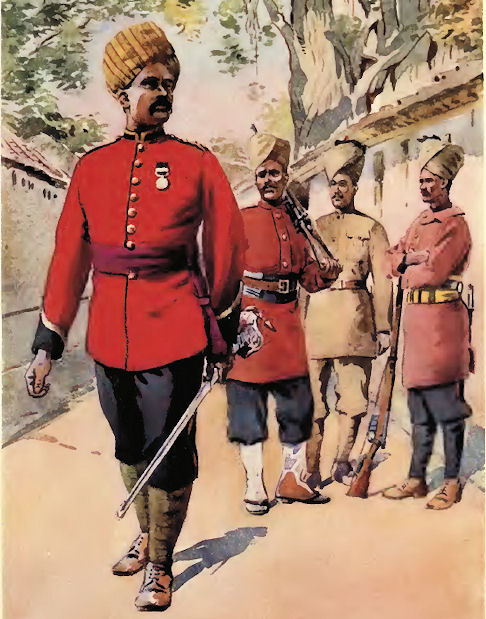
Abb.: । पत्तिसंहतिः । Mahratta Infantry
[Bildquelle: Lovett, A. C. (Alfred Crowdy) <1862 - 1919> <Painter> ; MacMunn,
G. F. (George Fletcher <1869 - 1952><Text>: The armies of India. -- London,
1911]
|
35c./d. śastrājīve kāṇḍapṛṣṭhāyudhīyāyudhikāḥ
samāḥ शस्त्राजीवे काण्डपृष्ठायुधीयायुधिकाः समाः ॥३५ ख॥ Bezeichnungen für einen Berfussoldaten / Söldner (शस्त्राजीव - śastrājīva 3 - von den Waffen lebend):
|
Colebrooke (1807): "A soldier by profession. These and following to V. 45 inclusive may be used adjectively."
शस्त्राजीव - śastrājīva 3 - von den Waffen lebend
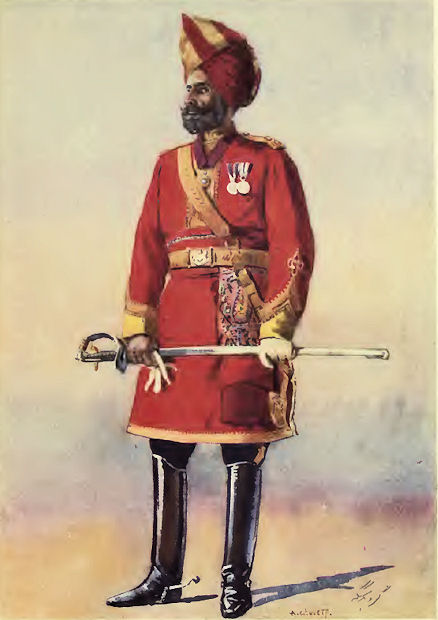
Abb.: शस्त्राजीवः । Commandant of Bharatpur Infantry
[Bildquelle: Lovett, A. C. (Alfred Crowdy) <1862 - 1919> <Painter> ; MacMunn,
G. F. (George Fletcher <1869 - 1952><Text>: The armies of India. -- London,
1911]
काण्डपृष्ठ - kāṇḍapṛṣṭha 3: "auf dem Rücken Pfeile tragend", Berufssoldat, Söldner
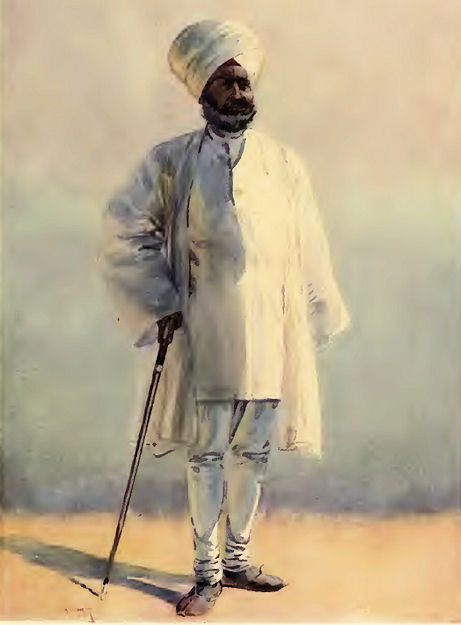
Abb.:
आयुधीय - āyudhīya 3: bewaffnet, Soldat
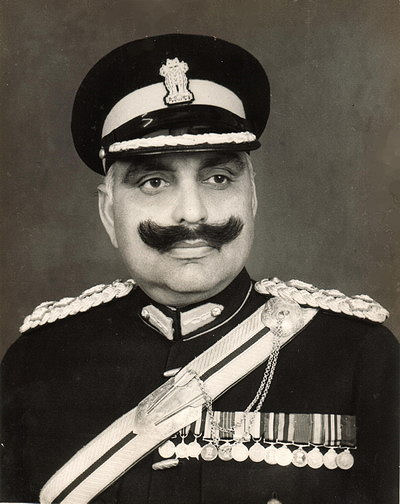
Abb.: आयुधीयः । Brig. Hari Singh (हरि सिंह) Deora A.V.S.M, 18th Cavalry (Indian Army)
(1922 - 2003)
[Bildquelle: Abhinayrathore / Wikimedia. -- Public domain]
आयुधिक - āyudhika 3: bewaffnet, Soldat
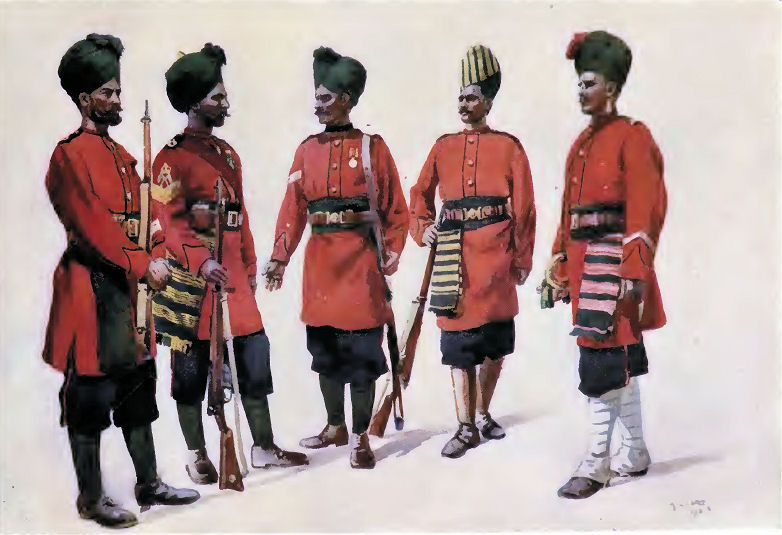
Abb.: आयुधिकाः । The former "Hyderabad Contingent" Infantry
[Bildquelle: Lovett, A. C. (Alfred Crowdy) <1862 - 1919> <Painter>
; MacMunn, G. F. (George Fletcher <1869 - 1952><Text>: The armies of India. --
London, 1911]
Zu kṣatriyavarga II. -- Vers 36 - 50b